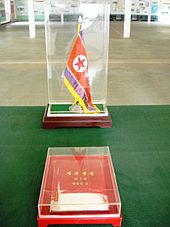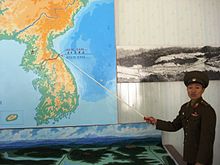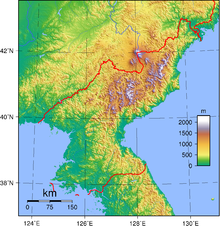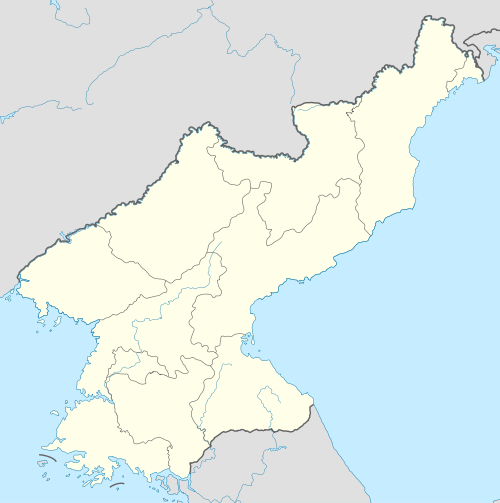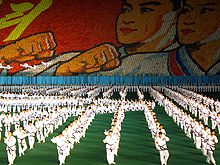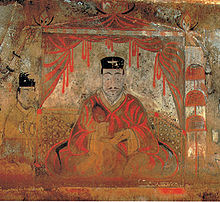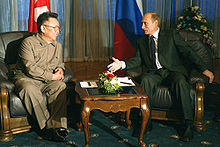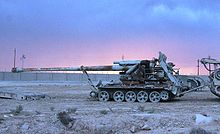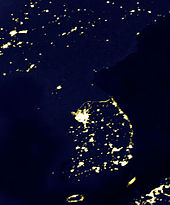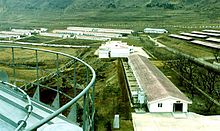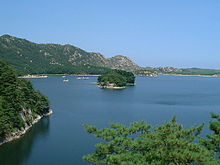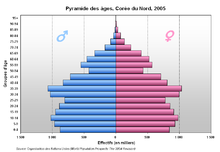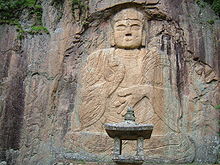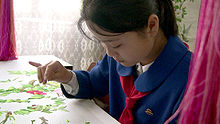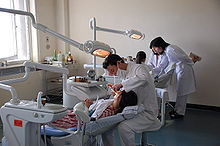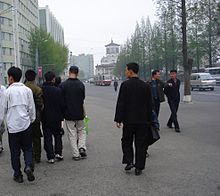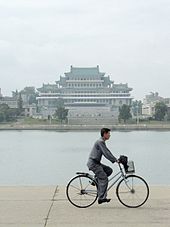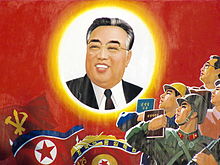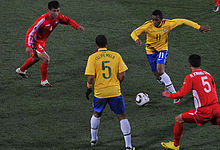- North Korea
-
Democratic People's Republic of Korea 

Flag Emblem Motto: 강성대국
(English: Powerful and Prosperous Nation),Anthem:
(tr.: Aegukka)
(English: The Patriotic Song)Capital
(and largest city)Pyongyang
39°2′N 125°45′E / 39.033°N 125.75°EOfficial language(s) Korean Official scripts Chosŏn'gŭl Ethnic groups Korean (100%) Demonym North Korean, Korean Government Juche unitary single-party state - Eternal President Kim Il-sung
(deceased)[a]- Supreme Leader[2][3] Kim Jong-il - NDC Chairman Kim Jong-il - Chairman of the Presidium Kim Yong-nam[b] - Premier Choe Yong-rim Legislature Supreme People's Assembly Establishment - Independence declared March 1, 1919 - Liberation August 15, 1945 - Formal declaration September 9, 1948 Area - Total 120,540 km2 (98th)
46,528 sq mi- Water (%) 4.87 Population - 2009 estimate 24,051,218[4] (51st) - 2008 census 24,052,231[5] - Density 198.3/km2 (55th)
513.8/sq miGDP (PPP) 2008[6] estimate - Total $40 billion (94th) - Per capita $1,900 (2009 est.)[7] (154th) GDP (nominal) 2009[7] estimate - Total $28.2 billion (88th) - Per capita $1,244[8] (139th) Gini (2009[9]) N/A Currency North Korean won (₩) ( KPW)Time zone Korea Standard Time (UTC+9) Date formats yy, yyyy년 mm월 dd일
yy, yyyy/mm/dd (CE–1911, CE)Drives on the right ISO 3166 code KP Internet TLD .kp Calling code 850 ^ a. Died 1994, named "Eternal President" in 1998.
^ b. Kim Yong-nam is the "head of state for foreign affairs".Coordinates: 40°00′N 127°00′E / 40°N 127°E
The Democratic People’s Republic of Korea (DPRK; Chosŏn'gŭl: 조선민주주의인민공화국, Hanja: 朝鮮民主主義人民共和國), (commonly known as North Korea
 i/ˌnɔrθ kəˈriə/), is a country in East Asia, occupying the northern half of the Korean Peninsula. Its capital and largest city is Pyongyang. The Korean Demilitarized Zone serves as the buffer zone between North Korea and South Korea. The Amnok, or Yalu, and the Tumen rivers form the border between North Korea and China. A section of the Tumen River in the far northeast is the border with Russia.
i/ˌnɔrθ kəˈriə/), is a country in East Asia, occupying the northern half of the Korean Peninsula. Its capital and largest city is Pyongyang. The Korean Demilitarized Zone serves as the buffer zone between North Korea and South Korea. The Amnok, or Yalu, and the Tumen rivers form the border between North Korea and China. A section of the Tumen River in the far northeast is the border with Russia.The peninsula was governed by the Korean Empire until it was annexed by Japan following the Russo-Japanese War of 1905. It was divided into Soviet and American occupied zones in 1945, following the end of World War II. North Korea refused to participate in a United Nations–supervised election held in the south in 1948, which led to the creation of separate Korean governments for the two occupation zones. Both North and South Korea claimed sovereignty over the Korean Peninsula as a whole, which led to the Korean War of 1950. The Armistice Agreement of 1953 ended the fighting; however, the two countries are officially still at war against each other, as a peace treaty was never signed.[10] Both states were accepted into the United Nations in 1991.[11]
North Korea is a single-party state under a united front led by the Korean Workers' Party (KWP).[12][13][14][15] The country's government follows the Juche ideology of self-reliance, developed by the country's President, Kim Il-sung. After his death, Kim Il-sung was declared the country's Eternal President. Juche became the official state ideology when the country adopted a new constitution in 1972,[16] though Kim Il-sung had been using it to form policy since at least as early as 1955.[17] After the collapse of the Soviet Union and a series of natural disasters, a famine occurred, causing the death of 900,000 to 2 million people.[18] Facing these circumstances, leader Kim Jong-Il adopted Songun, or a "military-first" policy in order to strengthen the country and its government.[19]
Many outside organizations describe North Korea as a totalitarian Stalinist dictatorship[13][14][20][21][22] with an elaborate cult of personality around the Kim family and one of the lowest-ranking human rights records of any country.[23] North Korea is the world's most militarized nation,[24][25] with a total of 9,495,000 active, reserve, and paramilitary personnel. It is a nuclear weapons state, and has an active space program.[26]
Contents
History
In the aftermath of the Japanese occupation of Korea which ended with Japan's defeat in World War II in 1945, Korea was divided at the 38th parallel in accordance with a United Nations arrangement, to be administered by the Soviet Union in the north and the United States in the south. The history of North Korea formally begins with the establishment of the Democratic People's Republic in 1948.
Division of Korea
In August 1945, the Soviet Army established a Soviet Civil Authority to rule the northern portion of the Korean Peninsula until a domestic regime, friendly to the USSR, could be established. This became governed by the Provisional People's Committee for North Korea through 1948. After the Soviet forces' departure in 1948, the main agenda in the following years was unification of Korea until the consolidation of Syngman Rhee regime in the South with American military support and the suppression of the October 1948 insurrection ended hopes that the country could be reunified by way of Communist revolution in the South. In 1949, a military intervention into South Korea was considered by Kim Il-sung, but failed to receive support from the Soviet Union, which had played a key role in the establishment of the country.[27]
The withdrawal of most United States forces from the South in June dramatically weakened the Southern regime and encouraged Kim Il-sung to rethink an invasion plan against the South.[27] The idea itself was first rejected by Joseph Stalin but with the development of Soviet nuclear weapons, Mao Zedong's victory in China and the Chinese indication that it would send troops and other support to North Korea, Stalin approved an invasion which led to the Korean War.[28]
Korean War
See also: Aftermath of the Korean War, Korean Demilitarized Zone, and North Korea – South Korea relationsAfter Korea was divided by the UN, the two Korean powers both tried to control the whole Korea under their respective governments. This led to escalating border conflicts on the 38th parallel and attempts to negotiate elections for the whole of Korea.[29] These attempts ended when the military of North Korea invaded the South on June 25, 1950, leading to a full-scale civil war. With endorsement from the United Nations, countries allied with the United States intervened on behalf of South Korea. After rapid advances in a South Korean counterattack, North-allied Chinese forces intervened on behalf of North Korea, shifting the balance of the war. Fighting ended on July 27, 1953, with an armistice that approximately restored the original boundaries between North and South Korea. More than 2 million civilians and soldiers were killed in the war.
Although some have referred to the conflict as a civil war, other important factors were involved.[30] The Korean War was also the first armed confrontation of the Cold War and set the standard for many later conflicts. It created the idea of a proxy war, where the two superpowers would fight in another country, forcing the people in that country to suffer most of the destruction and death involved in a war between such large nations. The superpowers avoided descending into an all-out war against one another, as well as the mutual use of nuclear weapons. It also expanded the Cold War, which to that point had mostly been concerned with Europe. A heavily guarded demilitarized zone on the 38th parallel still divides the peninsula, and an anti-Communist and anti-North Korea sentiment remains in South Korea.
Since the Armistice in 1953, relations between the North Korean government and South Korea, the European Union, Canada, the United States, and Japan have remained tense, and hostile incidents occur often.[31][page needed] North and South Korea signed the June 15th North-South Joint Declaration in 2000, in which they promised to seek peaceful reunification.[32] On October 4, 2007, the leaders of North and South Korea pledged to hold summit talks to officially declare the war over and reaffirmed the principle of mutual non-aggression.[33]
Late 20th century
The relative peace between the south and the north was interrupted by border skirmishes and assassination attempts. The North failed in several assassination attempts on South Korean leaders, most notably in 1968, 1974 and the Rangoon bombing in 1983; tunnels were frequently found under the DMZ and war nearly broke out over the Axe Murder Incident at Panmunjeom in 1976.[34] In 1973, extremely secret, high-level contacts began to be conducted through the offices of the Red Cross, but ended after the Panmunjeom incident with little progress having been made and the idea that the two Koreas would join international organisations separately.[35]
In the late 1990s, with the South having transitioned to liberal democracy, the success of the Nordpolitik policy, and power in the North having been taken up by Kim Il-sung's son Kim Jong-il, the two nations began to engage publicly for the first time, with the South declaring its Sunshine Policy.[36][37]
21st century
See also: Bombardment of YeonpyeongIn 2002, United States president George W. Bush labeled North Korea part of an "axis of evil" and an "outpost of tyranny". The highest-level contact the government has had with the United States was with U.S. Secretary of State Madeleine Albright, who made a visit to Pyongyang in 2000,[38] but the two countries do not have formal diplomatic relations.[7] By 2006, approximately 37,000 American soldiers remained in South Korea, although by June 2009 this number had fallen to around 30,000.[39][40] Kim Jong-il has privately stated his acceptance of U.S. troops on the peninsula, even after a possible reunification.[41] Publicly, North Korea strongly demands the removal of American troops from Korea.[41]
On June 13, 2009, the Associated Press reported that in response to new UN sanctions, North Korea declared it would progress with its uranium enrichment program. This marked the first time the DPRK has publicly acknowledged that it is conducting a uranium enrichment program.[42] In August 2009, former US president Bill Clinton met with Kim Jong-il to secure the release of two US journalists, who had been sentenced for entering the country illegally.[43] Current U.S. President Barack Obama's position towards North Korea has been to remain calm in the face of North Korea's provocations while resisting making deals with North Korea merely for the sake of defusing tension, a policy known as "strategic patience."[44]
On November 23, 2010, North Korea fired about 170 rounds of artillery on Yeonpyeong Island and the surrounding waters near the Yellow Sea border, with some 90 shells landing on the island. The attack resulted in the deaths of two marines and two civilians on the South Korean side, and fifteen marines and at least three civilians wounded.[45] The South fired back 80 shells, with unknown effects. North Korean news sources alleged that the North Korean actions, described as "a prompt and powerful physical strike", were in response to provocation from South Korea that had held an artillery exercise in the disputed waters south of the island.[46]
Former US President Jimmy Carter made a call for a peaceful solution of this crisis.[47]
Geography
North Korea occupies the northern portion of the Korean Peninsula, lying between latitudes 37° and 43°N, and longitudes 124° and 131°E. It covers an area of 120,540 square kilometres (46,541 sq mi). North Korea shares land borders with People's Republic of China and Russia to the north, and borders South Korea along the Korean Demilitarized Zone. To its west are the Yellow Sea and Korea Bay, and to its east lies Japan across the Sea of Japan (East Sea of Korea). The highest point in North Korea is Paektu-san Mountain at 2,744 metres (9,003 ft). The longest river is the Amnok River which flows for 790 kilometres (491 mi).[48] The capital and largest city is Pyongyang; other major cities include Kaesong in the south, Sinuiju in the northwest, Wonsan and Hamhung in the east and Chongjin in the northeast.
Topography
Early European visitors to Korea remarked that the country resembled "a sea in a heavy gale" because of the many successive mountain ranges that crisscross the peninsula.[49] Some 80% of North Korea is composed of mountains and uplands, separated by deep and narrow valleys, with all of the peninsula's mountains with elevations of 2,000 metres (6,600 ft) or more located in North Korea. The coastal plains are wide in the west and discontinuous in the east. A great majority of the population lives in the plains and lowlands.
The highest point in North Korea is Baekdu Mountain which is a volcanic mountain near the Chinese border with basalt lava plateau with elevations between 1,400 and 2,000 metres (4,600 and 6,600 ft) above sea level.[49] The Hamgyong Range, located in the extreme northeastern part of the peninsula, has many high peaks including Gwanmosan at approximately 1,756 m (5,761 ft).
Other major ranges include the Rangrim Mountains, which are located in the north-central part of North Korea and run in a north-south direction, making communication between the eastern and western parts of the country rather difficult; and the Kangnam Range, which runs along the North Korea–China border. Geumgangsan, often written Mt Kumgang, or Diamond Mountain, (approximately 1,638 metres or 5,374 feet) in the Taebaek Range, which extends into South Korea, is famous for its scenic beauty.[49]
For the most part, the plains are small. The most extensive are the Pyongyang and Chaeryong plains, each covering about 500 square kilometres (190 sq mi). Because the mountains on the east coast drop abruptly to the sea, the plains are even smaller there than on the west coast. Unlike neighboring Japan or northern China, North Korea experiences few severe earthquakes.
Climate
Main article: Climate of North KoreaNorth Korea has a continental climate with four distinct seasons.[50] Long winters bring bitter cold and clear weather interspersed with snow storms as a result of northern and northwestern winds that blow from Siberia. Average snowfall is 37 days during the winter. The weather is likely to be particularly harsh in the northern, mountainous regions.
Summer tends to be short, hot, humid, and rainy because of the southern and southeastern monsoon winds that bring moist air from the Pacific Ocean. Typhoons affect the peninsula on an average of at least once every summer.[50] Spring and autumn are transitional seasons marked by mild temperatures and variable winds and bring the most pleasant weather. Natural hazards include late spring droughts which often are followed by severe flooding. There are occasional typhoons during the early fall.
North Korea's climate is relatively temperate. Most of the country is classified as type Dwa in the Köppen climate classification scheme, with warm summers and cold, dry winters. In summer there is a short rainy season called changma.[51] On August 7, 2007, the most devastating floods in 40 years caused the North Korean government to ask for international help. NGOs, such as the Red Cross, asked people to raise funds because they feared a humanitarian catastrophe.[52]
Administrative divisions
Map Namea Chosŏn'gŭl Hanja Administrative Seat Directly governed citiy (chikhalsi)a 1 Pyongyang-chikhalsi 평양직할시 平壤直轄市 (Chung-guyok) Special city (teukbyeolsi)a 2 Rason-teukbyeolsi 라선특별시 羅先特別市 (Rajin-guyok) Provinces (do)a 3 Pyongannam-do 평안남도 平安南道 Pyongsong 4 Pyonganbuk-do 평안북도 平安北道 Sinuiju 5 Chagang-do 자강도 慈江道 Kanggye 6 Hwanghaenam-do 황해남도 黃海南道 Haeju 7 Hwanghaebuk-do 황해북도 黃海北道 Sariwon 8 Kangwon-do 강원도 江原道 Wonsan 9 Hamgyongnam-do 함경남도 咸鏡南道 Hamhung 10 Hamgyongbuk-do 함경북도 咸鏡北道 Chongjin 11 Ryanggang-do * 량강도 兩江道 Hyesan * – Rendered in Southern dialects as "Yanggang" (양강도). Largest cities of North Korea
2008 Census[5]Rank City Name Administrative division Pop. 
Pyongyang
1 Pyongyang Pyongyang Directly Governed City 3,255,288 2 Hamhung South Hamgyong Province 768,551 3 Chongjin North Hamgyong Province 667,929 4 Nampho South Pyongan Province 366,815 5 Wonsan Kangwon Province 363,127 6 Sinuiju North Pyongan Province 359,341 7 Tanchon South Hamgyong Province 345,875 8 Kaechon South Pyongan Province 319,554 9 Kaesong North Hwanghae Province 308,440 10 Sariwon North Hwanghae Province 307,764 Culture and arts
North Korea shares its traditional culture with South Korea, but the two Koreas have developed distinct contemporary forms of culture since the peninsula was divided in 1945. Historically, while the culture of Korea has been influenced by that of neighbouring China, it has nevertheless managed to develop a unique and distinct cultural identity from its larger neighbour.[53]
Literature and arts in North Korea are state-controlled, mostly through the Propaganda and Agitation Department or the Culture and Arts Department of the Central Committee of the KWP.[54]
Korean culture came under attack during the Japanese rule from 1910 to 1945. Japan enforced a cultural assimilation policy. During the Japanese rule, Koreans were encouraged to learn and speak Japanese, adopt the Japanese family name system and Shinto religion, and were forbidden to write or speak the Korean language in schools, businesses, or public places.[55] In addition, the Japanese altered or destroyed various Korean monuments including Gyeongbok Palace and documents which portrayed the Japanese in a negative light were revised.
In July 2004, the Complex of Goguryeo Tombs became the first site in the country to be included in the UNESCO list of World Heritage Sites.
In February 2008, The New York Philharmonic Orchestra became the first US orchestra to perform in North Korea,[56] albeit for a handpicked "invited audience."[57] The concert was broadcast on national television.[58] The U.S. Christian band Casting Crowns were previously invited to perform at the annual Spring Friendship Arts Festival in April 2007, held in Pyongyang.[59]
A popular event in North Korea is the Mass Games. The most recent and largest Mass Games was called "Arirang". It was performed six nights a week for two months, and involved over 100,000 performers. Attendees to this event in recent years report that the anti-West sentiments have been toned down compared to previous performances. The Mass Games involve performances of dance, gymnastics, and choreographic routines which celebrate the history of North Korea and the Workers' Party Revolution. The Mass Games are held in Pyongyang at various venues (varying according to the scale of the Games in a particular year) including the Rungrado May Day Stadium, which is the largest stadium in the world with a capacity of 150,000 people.
North Korea employs artists to produce art for export at the Mansudae Art Studio in Pyongyang. Over 1,000 artists are employed. Products include water colors, ink drawings, posters, mosaics and embroidery. Socialist realism is the approved style with North Korea being portrayed as prosperous and progressive and its citizens as happy and enthusiastic. Traditional Korean designs and themes are present most often in the embroidery. The artistic and technical quality of the works produced is very high but other than a few wealthy South Korean collectors there is a limited market due to public taste and reluctance of states and collectors to financially support the regime.[60]
Government and politics
North Korea is a self-described Juche (self-reliant) state,[61] described by some observers as a "hereditary dictatorship"[62] with a pronounced cult of personality organized around Kim Il-sung (the founder of North Korea and the country's only president) and his son and heir, Kim Jong-il. Following Kim Il-sung's death in 1994, he was not replaced but instead received the designation of "Eternal President", and was entombed in the vast Kumsusan Memorial Palace in central Pyongyang.[63]
Although the office of the President is ceremonially held by the deceased Kim Il-sung,[64][65][66] the de facto head of state is Kim Jong-il, who is Chairman of the National Defence Commission of North Korea and General Secretary of the Workers' Party of Korea. The legislature of North Korea is the Supreme People's Assembly, currently led by Chairman Kim Yong-nam. The other senior government figure is Premier Choe Yong-rim.
The structure of the government is described in the Constitution of North Korea, the latest version of which is from 2009 and officially rejects North Korea's founding ideology of communism.[67] The governing party by law is the Democratic Front for the Reunification of the Fatherland, a coalition of the Workers' Party of Korea and two other smaller parties, the Korean Social Democratic Party and the Chondoist Chongu Party. These parties nominate all candidates for office and hold all seats in the Supreme People's Assembly.
In June 2009, it was reported in South Korean media that intelligence indicates the country's next leader will be Kim Jong-un, the youngest of Kim Jong-il's three sons.[68][dated info]
Foreign relations
North Korea has long maintained close relations with the People's Republic of China and Russia. The fall of communism in eastern Europe in 1989, and the disintegration of the Soviet Union in 1991, resulted in a devastating drop in aid to North Korea from Russia, although China continues to provide substantial assistance. North Korea continues to have strong ties with its socialist southeast Asian allies in Vietnam and Laos, as well as with Cambodia.[69] North Korea has started installing a concrete and barbed wire fence on its northern border, in response to China's wish to curb refugees fleeing from North Korea. Previously the border between China and North Korea had only been lightly patrolled.[70]
As a result of the North Korean nuclear weapons program, the Six-party talks were established to find a peaceful solution to the growing tension between the two Korean governments, the Russian Federation, the People's Republic of China, Japan, and the United States.
On July 17, 2007, United Nations inspectors verified the shutdown of five North Korean nuclear facilities, according to the February 2007 agreement.[71]
On October 4, 2007, South Korean President Roh Moo-Hyun and North Korean leader Kim Jong-il signed an 8-point peace agreement, on issues of permanent peace, high-level talks, economic cooperation, renewal of train, highway and air travel, and a joint Olympic cheering squad.[33]
The United States and South Korea previously designated the North as a state sponsor of terrorism.[72] The 1983 bombing that killed members of the South Korean government and the destruction of a South Korean airliner have been attributed to North Korea.[73] North Korea has also admitted responsibility for the kidnapping of 13 Japanese citizens in the 1970s and 1980s, five of whom were returned to Japan in 2002.[74] On October 11, 2008, the United States removed North Korea from its list of states that sponsor terrorism.[75]
In 2009, relationships between North and South Korea increased in intensity; North Korea had been reported to have deployed missiles,[76] ended its former agreements with South Korea,[77] and threatened South Korea and the United States not to interfere with a satellite launch it had planned.[78] North and South Korea are still technically at war (having never signed a peace treaty after the Korean War) and share the world’s most heavily fortified border.[79] On May 27, 2009, North Korean media declared that the Korean Armistice was no longer valid due to the South Korean government's pledge to "definitely join" the Proliferation Security Initiative.[citation needed] To further complicate and intensify strains between the two nations, the sinking of the South Korean warship Cheonan in March 2010, killing 46 seamen, is as of May 20, 2010 claimed by a multi-national research team[80] to have been caused by a North Korean torpedo, which the North denies. South Korea agreed with the findings from the research group and President Lee Myung-bak declared in May 2010 that Seoul would cut all trade with North Korea as part of measures primarily aimed at striking back at North Korea diplomatically and financially.[81] As a result of this, North Korea severed all ties, completely abrogated the previous pact of non aggression and expelled all South Koreans from a joint industrial zone in Kaesong.[82] On November 23, 2010, North Korea attacked Yeonpyeong Island, further deteriorating the diplomatic relations with the South and other nations.[83]
Most of the foreign embassies connecting with diplomatic ties to North Korea are situated in Beijing rather than Pyongyang.[84]
Military
The Korean People's Army (KPA) is the name for the collective armed personnel of the North Korean military. It has five branches: Ground Force, Naval Force, Air Force, Special Operations Force, and Rocket Force. According to the U.S. Department of State, North Korea has the fourth-largest army in the world, at an estimated 1.21 million armed personnel, with about 20% of men aged 17–54 in the regular armed forces.[85] North Korea has the highest percentage of military personnel per capita of any nation in the world, with approximately one enlisted soldier for every 25 citizens.[24][86]
Military strategy is designed for insertion of agents and sabotage behind enemy lines in wartime,[85] with much of the KPA's forces deployed along the heavily fortified Korean Demilitarized Zone. The Korean People's Army operates a very large amount of equipment, including 4,060 tanks, 2,500 APCs, 17,900 artillery pieces, 11,000 air defence guns and some 10,000 MANPADS and anti-tank guided missiles[87] in the Ground force; at least 915 vessels in the Navy and 1,748 aircraft in the Air Force,[88] of which 478 are fighters and 180 are bombers.[89] North Korea also has the largest special forces in the world, as well as the largest submarine fleet.[90] The equipment is a mixture of World War II vintage vehicles and small arms, widely proliferated Cold War technology, and more modern Soviet or locally produced weapons. In line with its asymmetric warfare strategy, North Korea has also developed a wide range of unconventional techniques and equipment, such as GPS jammers,[91] stealth paint,[92] midget submarines and human torpedoes,[93] a vast array of chemical and biological weapons,[94] and anti-personnel lasers.[95] According to official North Korean media, military expenditures for 2010 amount to 15.8% of the state budget.[96]
North Korea has active nuclear and ballistic missile weapons programs and has been subject to United Nations Security Council resolutions 1695 of July 2006, 1718 of October 2006, and 1874 of June 2009, for carrying out both missile and nuclear tests. North Korea probably has fissile material for up to nine nuclear weapons,[97] and has the capability to deploy nuclear warheads on intermediate-range ballistic missiles.[98]
Economy
North Korea has an industrialised, near-autarkic, highly centralized command economy. Of the five remaining Communist states in the world, North Korea is one of only two (along with Cuba) with an almost entirely government-planned, state-owned economy. The Central Planning Committee prepares, supervises and implements economic plans, while a General Bureau of Provincial Industry in each region is responsible for the management of local manufacturing facilities, production, resource allocation and sales.[101]
North Korea's isolation policy means that international trade is highly restricted. North Korea passed a law in 1984 allowing for foreign investment through joint ventures,[102] but failed to attract any significant investment. In 1991, it established the Rason Economic Special Zone,[103] in an attempt to attract foreign investment from China and Russia. Chinese and Russian companies have purchased rights to use the ports at Rason. Chinese investors are renovating a road from Rason to China,[104] and Russian railway workers are renovating the railway from Rason to Russia, from where it continues onto the Trans-Siberian Railway.[105]
Until 1998, the United Nations published HDI and GDP per capita figures for North Korea, which stood at a medium level of human development at 0.766 (ranked 75th) and a GDP per capita of $4,058.[106] The average salary was about $47 per month in 2004.[107] The average official salary in 2011 was equivalent to $2 per month while the actual monthly income seems to be around $15 because most North Koreans earn money in illegal small businesses: trade, subsistence farming, and handicrafts. The illegal economy is dominated by women because men have to attend their places of official work even though most of the factories are non-functioning.[108] It is estimated that in the early 2000s, the average North Korean family drew some 80% of its income from small businesses that are legal in market economies but illegal in North Korea.[109]
Despite substantial economic problems, quality of life was improving and wages were rising steadily in 2007.[110] Small-scale private markets, known as janmadang, exist throughout the country and provide the population with imported food and commodities ranging from cosmetics to motorcycles in exchange for money.[111][112] In 2009, the government carried out a currency redenomination with the aim to curb free market activity across the country, but the attempt failed, causing inflation rates to skyrocket, and eventually led to the lifting of the ban on free market trade.[113]
Food rations, housing, healthcare, and education are offered from the state for free,[114] and the payment of taxes has been abolished since April 1, 1974.[115] In order to increase productivity from agriculture and industry, since the 1960s the North Korean government has introduced a number of management systems such as the Taean work system.[116] In the 21st century, North Korea's GDP growth has been slow but steady, although in recent years, growth has gradually accelerated to 3.7% in 2008, the fastest pace in almost a decade, largely due to a sharp growth of 8.2% in the agricultural sector.[117]
GDP Growth by year[117][118] 2000 2001 2002 2003 2004 2005 2006 2007 2008 2009 1.3% 3.7% 1.2% 1.8% 2.2% 1.0% 1.6% 1.8% 3.7% 3.7% Based on estimates in 2002, the dominant sector in the North Korean economy is industry (43.1%), followed by services (33.6%) and agriculture (23.3%). In 2004, it was estimated that agriculture employed 37% of the workforce while industry and services employed the remaining 63%.[7] Major industries include military products, machine building, electric power, chemicals, mining, metallurgy, textiles, food processing and tourism. Iron ore and coal production are among the few sectors where North Korea performs significantly better than its southern neighbour - the DPRK produces about 10 times larger amounts of each resource.[119]
Rice yields are about 2.8 tonnes per hectare, about half that in most countries, with soil degradation, lack of fertilisers and limited mechanisation blamed.[120] In 2005, North Korea was ranked by the FAO as an estimated 10th in the production of fresh fruit[121] and as an estimated 19th in the production of apples.[122] It has substantial natural resources and is the world's 18th largest producer of iron and zinc, having the 22nd largest coal reserves in the world. It is also the 15th largest fluorite producer and 12th largest producer of copper and salt in Asia. Other major natural resources in production include lead, tungsten, graphite, magnesite, gold, pyrites, fluorspar, and hydropower.[7]
Private commerce
In 1991, North Korea started experimenting with private capitalism in the Rajin-Sonbong Economic Special Zone, and in 2002 also set up the Kaesong Industrial Region.[123] A small number of other areas have been designated as Special Administrative Regions. China and South Korea are the biggest trade partners of North Korea, with trade with China increasing 15% to US$1.6 billion in 2005, and trade with South Korea increasing 50% to over 1 billion for the first time in 2005.[124] China is North Korea's closest economic partner, with 73% of North Korea's foreign trade being conducted with this country.[125]
In 2000, Centre for the Study of the Capitalist System was established.[126] Increasingly more foreign-invested joint ventures have been set up since 2002.[127] The Pyongyang Business School was established by the Swiss government to help teach students business management.[128]
A small number of capitalistic elements are gradually spreading from the trial area, including a number of advertising billboards along certain highways. Recent visitors have reported that the number of open-air farmers' markets has increased in Kaesong and Pyongyang, as well as along the China-North Korea border, bypassing the food rationing system. In addition to food aid, China reportedly provides an estimated 80 to 90 percent of North Korea's oil imports at "friendly prices" that are sharply lower than the world market price.[129]
North Korea also has a cartoon animation industry, sub-contracting work from South Korean animation studios.[130]
Tourism
Tourism in North Korea is organized by the state owned Korea International Travel Company. Every group of travelers as well as individual tourists/visitors is permanently accompanied by one or two "guides" who normally speak the mother language of the tourist. While tourism has increased over the last few years, tourists from Western countries remain few.
The majority of the tourists who visit come from China, Russia, and Japan. Russian citizens from the Asian part of Russia prefer North Korea as a tourist destination due to the relatively low prices, lack of pollution and the warmer climate. For citizens of South Korea, it is practically impossible to obtain a visa for North Korea; however, they can still obtain "entry permits" to special tourist areas designated for South Koreans, such as Kaesong. US citizens were also subject to visa restrictions, only able to visit during the yearly Arirang Festival. These restrictions were lifted in January 2010, yet currently fewer than 2,500 U.S. citizens have visited North Korea since 1953.[131]
In the area of the Kŭmgangsan-mountains, the company Hyundai established and operates a special Tourist area. Traveling to this area is also possible for South Koreans and US citizens, but only in organized groups from South Korea. A special administrative region known as the Kŭmgangsan Tourist Region exists for this purpose. However, trips to the region were suspended after a South Korean woman who wandered into a controlled military zone was shot dead by border guards in late 2008.[132] When tours had still not resumed by May 2010, North Korea unilaterally announced that it would seize South Korean real estate assets in the region.[133]
Famine
In the 1990s North Korea faced significant economic disruptions, including a series of natural disasters, economic mismanagement and serious resource shortages after the collapse of the Eastern Bloc. These resulted in a shortfall of staple grain output of more than 1 million tons from what the country needs to meet internationally accepted minimum dietary requirements.[134] The North Korean famine known as "Arduous March" resulted in the deaths of between 300,000 and 800,000 North Koreans per year during the three year famine, peaking in 1997.[18] The deaths were most likely caused by famine-related illnesses such as pneumonia, tuberculosis, and diarrhea rather than starvation.[18]
In 2006, Amnesty International reported that a national nutrition survey conducted by the North Korean government, the World Food Programme, and UNICEF found that 7% of children were severely malnourished; 37% were chronically malnourished; 23.4% were underweight; and one in three mothers was malnourished and anaemic as the result of the lingering effect of the famine. The inflation caused by some of the 2002 economic reforms, including the Songun or "Military-first" policy, was cited for creating the increased price of basic foods.[135]
The history of Japanese assistance to North Korea has been marked with challenges; from a large pro-Pyongyang community of Koreans in Japan to public outrage over the 1998 North Korean missile launch and revelations regarding the abduction of Japanese citizens.[136] In June 1995 an agreement was reached that the two countries would act jointly.[136] South Korea would provide 150,000 MT of grain in unmarked bags, and Japan would provide 150,000 MT gratis and another 150,000 MT on concessional terms.[136] In October 1995 and January 1996, North Korea again approached Japan for assistance. On these two occasions, both of which came at crucial moments in the evolution of the famine, opposition from both South Korea and domestic political sources quashed the deals.[136]
Beginning in 1997, the U.S. began shipping food aid to North Korea through the United Nations World Food Programme (WFP) to combat the famine. Shipments peaked in 1999 at nearly 700,000 tons making the U.S. the largest foreign aid donor to the country at the time. Under the Bush Administration, aid was drastically reduced year after year from 350,000 tons in 2001 to 40,000 in 2004.[137] The Bush Administration took criticism for using "food as a weapon" during talks over the North's nuclear weapons program, but insisted the U.S. Agency for International Development (USAID) criteria were the same for all countries and the situation in North Korea had "improved significantly since its collapse in the mid-1990s." Agricultural production had increased from about 2.7 million metric tons in 1997 to 4.2 million metric tons in 2004.[138]
Media and Telecommunications
Media
North Korean media are under one of the strictest government controls in the world. The North Korean constitution provides for freedom of speech and the press; however, the government prohibits the exercise of these rights in practice. In its 2010 report, Reporters Without Borders ranked the freedom of the press in North Korea as 177th out of 178, above only that of Eritrea.[139] Only news that favors the regime is permitted, while news that covers the economic and political problems in the country, or criticisms of the regime from abroad, is not allowed.[140] The media upholds the personality cult of Kim Jong-il, regularly reporting on his daily activities. The main news provider to media in the DPRK is the Korean Central News Agency.
North Korea has 12 principal newspapers and 20 major periodicals, all of varying periodicity and all published in Pyongyang.[141] Newspapers include the Rodong Sinmun, Joson Inmingun, Minju Choson, and Rodongja Sinmum. No private press exists.[142]
Telephones and Internet
North Korea has an adequate telephone system, with 1.18 million fixed lines available in 2008.[143] However, most phones are only installed for senior government officials. If one wants a phone installed, they would need to fill out a form indicating their rank, why they want a phone and how they will pay for it.[144] The number of mobile phones in Pyongyang rose from only 3,000 in 2002 to approximately 20,000 during 2004.[145] In June 2004, however, mobile phones were forbidden again,[146] until a new 3G network, Koryolink, was built in 2008 through a joint venture with Orascom Telecom Holding of Egypt. In May 2010, over 120,000 North Koreans owned a mobile phone,[147] and by September the same year the number of subscribers increased more than twice, reaching 301,000 people.[148] By August 2011, the number of mobile phone subscribers had increased to 660,000 users.[149]
North Korea's first Internet café opened in 2002 as a joint venture with South Korean internet company Hoonnet. Ordinary North Koreans do not have access to the global Internet network, but are provided with a nationwide, public use Intranet service called Kwangmyong, which features domestic news, an e-mail service and censored information from foreign websites (mostly scientific).[150]
Transportation
Two of the few ways to enter North Korea are over the Sino-Korea Friendship Bridge or via Panmunjeom, the former crossing the Amnok River and the latter crossing the Demilitarized Zone.
On October 13, 2011 a train from the Russian border town of Khasan made an inaugural run to Rajin in North Korea. It run a 54-kilometer along a newly repaired link of reconstruction all the Trans-Korean rail for its further integration into the Trans-Siberian railroad.[151]
Private cars in North Korea are a rare sight, but as of 2008[update] some 70% of households used bicycles, which also play an increasingly important role in small-scale private trade.[152] Very few cars and light trucks are made in a joint-venture between Pyeonghwa Motors of South Korea, and the North Korean Ryonbong General Corp at a facility in Nampo North Korea.[153] Another local producer of vehicles is Sungri Motor Plant, which manufactures civilian vehicles and heavy trucks.
There is a mix of locally built and imported trolleybuses and trams in urban centers in North Korea. Earlier fleets were obtained in Europe and China, but the trade embargo has forced North Korea to build their own vehicles.
Rail transport
Choson Cul Minzuzui Inmingonghoagug is the only rail operator in North Korea. It has a network of 5,200 km (3,200 mi) of track with 4,500 km (2,800 mi) in standard gauge.[154] There is a small narrow gauge railway in operation in Haeju peninsula.[154] The railway fleet consists of a mix of electric and steam locomotives. Cars are mostly made in North Korea using Soviet and Chinese designs. There are some locomotives from Imperial Japan, the United States, and Europe remaining in use. Second-hand Chinese locomotives (early DF4Bs, BJ Hydraulics, etc.) have also been spotted in active service.
People traveling from the capital Pyongyang to other regions in North Korea typically travel by rail. But in order to travel out of Pyongyang, people need an official travel certificate, ID, and a purchased ticket in advance. Due to lack of maintenance on the infrastructure and vehicles, the travel time by rail is increasing. It has been reported that the 120 mile (193 km) trip from Pyongyang to Kaesong can take up to 6 hours.[155]Marine transport
Water transport on the major rivers and along the coasts plays a growing role in freight and passenger traffic. Except for the Yalu and Taedong rivers, most of the inland waterways, totaling 2,253 kilometres (1,400 mi), are navigable only by small boats. Coastal traffic is heaviest on the eastern seaboard, whose deeper waters can accommodate larger vessels. The major ports are Nampho on the west coast and Rajin, Chongjin, Wonsan, and Hamhung on the east coast. The country's harbor loading capacity in the 1990s was estimated at almost 35 million tons a year.[156]
In the early 1990s, North Korea possessed an oceangoing merchant fleet, largely domestically produced, of sixty-eight ships (of at least 1,000 gross-registered tons), totaling 465,801 gross-registered tons (709,442 metric tons deadweight (DWT)), which includes fifty-eight cargo ships and two tankers. There is a continuing investment in upgrading and expanding port facilities, developing transportation—particularly on the Taedong River—and increasing the share of international cargo by domestic vessels.[157]
Air transport
North Korea's international air connections are limited. There are regularly scheduled flights from the Sunan International Airport – 24 kilometres (15 mi) north of Pyongyang – to Moscow, Khabarovsk, Vladivostok, Bangkok, Beijing, Dalian, Shanghai, Shenyang along with seasonal services to Singapore and charter flights from Sunan to numerous Asian and European destinations including Tokyo and Nagoya. Regular charters to existing scheduled services are operated as per demand. An agreement to initiate a service between Pyongyang and Tokyo was signed in 1990. Internal flights are available between Pyongyang, Hamhung, Haeju, Kaesong, Kanggye, Kilju, Nampo, Sinuiju, Samjiyon, Wonsan, and Chongjin.[158]
All civil aircraft are operated by Air Koryo: 38 aircraft in 2010, which were purchased from the Soviet Union and Russia. From 1976 to 1978, four Tu-154 jets were added to the 7 of propeller-driven An-24s and 2 Ilyushin Il-18's afterwards adding four long range Ilyushin Il-62M, three Ilyushin Il-76MD large cargo aircraft. In 2008 a long range Tupolev Tu-204-300's purchased along with a larger version the Tupolev Tu-204-100B in 2010.[156]
Demographics
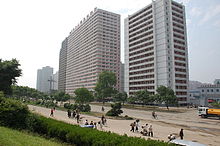 Prefabricated apartments house a large portion of the population. Housing in North Korea is free, but cramped as with many other Asian nations.[159]
Prefabricated apartments house a large portion of the population. Housing in North Korea is free, but cramped as with many other Asian nations.[159]
North Korea's population of roughly 24 million is one of the most ethnically and linguistically homogeneous in the world, with very small numbers of Chinese, Japanese, Vietnamese, South Korean, and European expatriate minorities.
According to the CIA World Factbook, North Korea's life expectancy was 63.8 years in 2009, a figure roughly equivalent to that of Pakistan and Burma and slightly lower than Russia.[160] Infant mortality stood at a high level of 51.3, which is 2.5 times higher than that of China, 5 times that of Russia, 12 times that of South Korea.[161]
According to the UNICEF "The State of the world's Children 2003" North Korea appears ranked at the 73rd place (with first place having the highest mortality rate), between Guatemala (72nd) and Tuvalu (74th).[161][162] North Korea's Total fertility rate is relatively low and stood at 2.0 in 2009, comparable to those of the United States and France.[163]
Language
North Korea shares the Korean language with South Korea. There are dialect differences within both Koreas, but the border between North and South does not represent a major linguistic boundary. While prevalent in the South, the adoption of modern terms from foreign languages has been limited in North Korea. Hanja (Chinese characters) are no longer used in North Korea, although still occasionally used in South Korea. Both Koreas share the phonetic writing system called Chosongul in the north and Hangul south of the DMZ. The official Romanization differs in the two countries, with North Korea using a slightly modified McCune-Reischauer system, and the South using the Revised Romanization of Korean.
Religion
Both Koreas share a Buddhist and Confucian heritage and a recent history of Christian and Cheondoism ("religion of the Heavenly Way") movements. The North Korean constitution states that freedom of religion is permitted.[164] According to the Western standards of religion, the majority of the North Korean population could be characterized as irreligious. However, the cultural influence of such traditional religions as Buddhism and Confucianism still have an effect on North Korean spiritual life.[165][166][167]
Nevertheless, Buddhists in North Korea reportedly fare better than other religious groups, particularly Christians, who are said to face persecution by the authorities. Buddhists are given limited funding by the government to promote the religion, because Buddhism played an integral role in traditional Korean culture.[168]
According to Human Rights Watch, free religious activities no longer exist in North Korea, as the government sponsors religious groups only to create an illusion of religious freedom.[169] According to Religious Intelligence the situation of religion in North Korea is the following:[170]
- Irreligion: 15,460,000 (64.3% of population, the vast majority of which are adherents of the Juche philosophy)
- Korean shamanism: 3,846,000 adherents (16% of population)
- Cheondoism: 3,245,000 adherents (13.5% of population)
- Buddhism: 1,082,000 adherents (4.5% of population)
- Christianity: 406,000 adherents (1.7% of population)
Pyongyang was the center of Christian activity in Korea until 1945. From the late forties 166 priests and other religious figures were killed or kidnapped (disappeared without trace), including Francis Hong Yong-ho, bishop of Pyongyang.[171] No Catholic priest survived the persecution, all churches were destroyed and the government never allowed any foreign priest to set up in North Korea.
Today, four state-sanctioned churches exist, which freedom of religion advocates say are showcases for foreigners.[172][173] Official government statistics report that there are 10,000 Protestants and 4,000 Roman Catholics in North Korea.[174]
According to a ranking published by Open Doors, an organization that supports persecuted Christians, North Korea is currently the country with the most severe persecution of Christians in the world.[175] Open Doors estimates that 50000 – 70000 Christians are detained in North Korean prison camps.[176] Human rights groups such as Amnesty International also have expressed concerns about religious persecution in North Korea.[177]
Education
Education in North Korea is free of charge,[178] compulsory until the secondary level, and is controlled by the government. The state also used to provide school uniforms free of charge until the early 1990s.[179] Heuristics is actively applied in order to develop the independence and creativity of students.[180] Compulsory education lasts eleven years, and encompasses one year of preschool, four years of primary education and six years of secondary education. The school curriculum has both academic and political content.[181]
Primary schools are known as people's schools, and children attend them from the age of 6 to 9. Then from age 10 to 16, they attend either a regular secondary school or a special secondary school, depending on their specialties.
Higher education is not compulsory in North Korea. It is composed of two systems: academic higher education and higher education for continuing education. The academic higher education system includes three kinds of institutions: universities, professional schools, and technical schools. Graduate schools for master's and doctoral level studies are attached to universities, and are for students who want to continue their education. Two notable universities in the DPRK are the Kim Il-sung University and Pyongyang University of Science and Technology, both in Pyongyang. The former, founded in October 1946, is an elite institution whose enrollment of 16,000 full- and part-time students in the early 1990s occupies, in the words of one observer, the "pinnacle of the North Korean educational and social system."[182]
North Korea is one of the most literate countries in the world, with an average literacy rate of 99%.[7]
Health care
Main article: Health Care in North KoreaNorth Korea has a national medical service and health insurance system.[183] North Korea spends 3% of its gross domestic product on health care. Beginning in the 1950s, the DPRK put great emphasis on healthcare, and between 1955 and 1986, the number of hospitals grew from 285 to 2,401, and the number of clinics – from 1,020 to 5,644.[184] There are hospitals attached to factories and mines. Since 1979 more emphasis has been put on traditional Korean medicine, based on treatment with herbs and acupuncture.
North Korea's healthcare system has been in a steep decline since the 1990s due to natural disasters, economic problems, and food and energy shortages. Many hospitals and clinics in North Korea now lack essential medicines, equipment, running water and electricity.[185]
Almost 100% of the population has access to water and sanitation, but it is not completely potable. Infectious diseases, such as tuberculosis, malaria, and hepatitis B, are considered to be endemic to the country.[186] Life expectancy in North Korea is 63.8 years, occupying the 170th place in the world, according to 2009 estimates.[160]
Among other health problems, many North Korean citizens suffer from the after effects of malnutrition, caused by famines related to the failure of its food distribution program and "military first" policy. A 1998 United Nations (UN) World Food Program report revealed that 60% of children suffered from malnutrition, and 16% were acutely malnourished. As a result, those who suffered during the disaster have ongoing health problems.
Society
Human rights
Multiple international human rights organizations, including Amnesty International and Human Rights Watch, accuse North Korea of having one of the worst human rights records of any nation.[187] North Koreans have been referred to as "some of the world's most brutalized people" by Human Rights Watch, due to the severe restrictions placed on their political and economic freedoms.[188]
North Korean defectors have testified to the existence of prisons and concentration camps[189] with an estimated 150,000 to 200,000 inmates[190] (about 0.85% of the population), and have reported torture, starvation, rape, murder, medical experimentation, forced labour, and forced abortions.[191] Convicted political prisoners and their families are sent to these camps, where they are prohibited from marrying, required to grow their own food, and cut off from external communication (which was previously allowed).[192]
The system changed slightly at the end of 1990s, when population growth became very low. In many cases, where capital punishment was de facto[citation needed], it was replaced by less severe punishments. Bribery became prevalent throughout the country.[193] For example, years ago[specify] just listening to South Korean radio could result in capital punishment[citation needed]. However, many North Koreans now illegally wear clothes of South Korean origin, listen to Southern music, watch South Korean videotapes and even receive Southern broadcasts.[194][195]
Personality cult
The North Korean government exercises control over many aspects of the nation's culture, and this control is used to perpetuate a cult of personality surrounding Kim Il-sung, and, to a lesser extent, Kim Jong-il. While visiting North Korea in 1979, journalist Bradley Martin noted that nearly all music, art, and sculpture that he observed glorified "Great Leader" Kim Il-sung, whose personality cult was then being extended to his son, "Dear Leader" Kim Jong-il.[196] There is even widespread belief that Kim Il-sung "created the world", and Kim Jong-il can "control the weather".[196]
The song "No Motherland Without You" (당신이없으면 조국도없다), sung by the North Korean Army Choir, was created especially for Kim Jong-il and is one of the most popular tunes in the country. Kim Il-sung is still officially revered as the nation's "Eternal President". Several landmarks in North Korea are named for Kim Il-sung, including Kim Il-sung University, Kim Il-sung Stadium, and Kim Il-sung Square. Defectors have been quoted as saying that North Korean schools deify both father and son.[197] Kim Il-sung rejected the notion that he had created a cult around himself, and accused those who suggested this of "factionalism".[196]
Critics maintain this Kim Jong-il personality cult was inherited from his father, Kim Il-sung. Kim Jong-il is often the center of attention throughout ordinary life in the DPRK. His birthday is one of the most important public holidays in the country. On his 60th birthday (based on his official date of birth), mass celebrations occurred throughout the country.[198] Kim Jong-il's personality cult, although significant, is not as extensive as his father's. In 2004, some of his official portraits were taken down from public buildings.[199] One point of view is that Kim Jong-il's cult of personality is solely out of respect for Kim Il-sung or out of fear of punishment for failure to pay homage.[200] Media and government sources from outside of North Korea generally support this view,[201][202][203][204][205] while North Korean government sources say that it is genuine hero worship.[206]
Korean reunification
North Korea's policy is to seek reunification without what it sees as outside interference, through a federal structure retaining each side's leadership and systems. Both North and South Korea signed the June 15th North–South Joint Declaration in which both sides made promises to seek out a peaceful reunification.[207] The Democratic Federal Republic of Korea is a proposed state first mentioned by then North Korean president Kim Il-sung on October 10, 1980, proposing a federation between North and South Korea in which the respective political systems would initially remain.[208]
Sports
Perhaps the most well known sporting event in North Korea is the annual Arirang Festival. The main attraction of Arirang is the mass gymnastics display. In football, fifteen clubs compete in the DPR Korea League level-one and vie for both the Technical Innovation Contests and the Republic Championship. The national football team, Chollima, compete in the AFC and are ranked 105 by FIFA as of 26 May 2010. The team competed in the FIFA World Cup in 1966 and 2010. In hockey, North Korea has a men’s team that is ranked 43rd out of 49[209] and competes in Division II. The women’s team is ranked 21 out of 34[210] and competes in Division II.
North Korea has been competing in the Olympics since 1964 and debuted at the summer games in 1972 by taking home five medals, including one gold. The IOC Code is PRK. At the Athens Games in 2004, the North and South marched together in the opening and closing ceremonies under the Unification Flag, but competed separately. To date, North Korea has medaled in every summer Olympics in which they have participated.
The martial art taekwondo originated in Korea. In the 1950s and 60s, modern rules were standardised and taekwondo became an official Olympic sport in 2000. Other Korean martial arts include taekkyeon, hapkido, tang soo do, kuk sool won, kumdo and subak.
See also
- Outline of North Korea
- Index of North Korea-related articles
References
- ^ "Administrative Population and Divisions Figures (#26)" (PDF). DPRK: The Land of the Morning Calm. Permanent Committee on Geographical Names for British Official Use. 2003-04. http://www.pcgn.org.uk/North%20Korea-%20Land%20of%20the%20Morning%20Calm-%202003.pdf. Retrieved 2006-10-10.
- ^ Choe, Sang-Hun (2009-09-28). "New North Korean Constitution Bolsters Kim’s Power". New York Times. http://www.nytimes.com/2009/09/29/world/asia/29korea.html. Retrieved 2009-09-30.
- ^ McGivering, Jill (2009-09-29). "N Korea constitution bolsters Kim". BBC. http://news.bbc.co.uk/2/hi/asia-pacific/8279830.stm. Retrieved 2009-09-30.
- ^ (Korean) UNFPA (2009-10-01). 한반도 인구 7천400만명 시대 임박. United Nations. http://news.joins.com/article/686/4109686.html. Retrieved 2010-04-14.[dead link]
- ^ a b "DPR Korea 2008 Population Census National Report". Pyongyang: DPRK Central Bureau of Statistics. 2009. http://unstats.un.org/unsd/demographic/sources/census/2010_PHC/North_Korea/Final%20national%20census%20report.pdf. Retrieved 2011-02-19.
- ^ "Country Profile: North Korea". Foreign and Commonwealth Office, UK. 2009-06-25. http://www.fco.gov.uk/en/travel-and-living-abroad/travel-advice-by-country/country-profile/asia-oceania/north-korea?profile=economy. Retrieved 2010-02-10.
- ^ a b c d e f "Korea, North". The World Factbook. 2009. https://www.cia.gov/library/publications/the-world-factbook/geos/kn.html#Econ. Retrieved 2010-05-17.
- ^ GDP (official exchange rate), The World Factbook, Central Intelligence Agency, last updated on April 26, 2010; accessed on May 17, 2010. Population data obtained from Total Midyear Population, U.S. Census Bureau, International Data Base, accessed on May 17, 2010. Note: Per capita values were obtained by dividing the GDP (official exchange rate) data by the Population data.
- ^ "Korea, North". The United Nations Human Development Report. 2009). http://hdrstats.undp.org/en/indicators/161.html. Retrieved 2009-10-09.
- ^ "U.S.: N. Korea Boosting Guerrilla War Capabilities". FOX News Network, LLC. 2009-06-23. http://www.foxnews.com/story/0,2933,528320,00.html. Retrieved 2009-07-04.
- ^ Sanger, David E. (1991-05-29). "North Korea Reluctantly Seeks U.N. Seat". The New York Times Company. http://www.nytimes.com/1991/05/29/world/north-korea-reluctantly-seeks-un-seat.html. Retrieved 2009-07-04.
- ^ Spencer, Richard (2007-08-28). "North Korea power struggle looms". The Telegraph (online version of UK national newspaper) (London). http://www.telegraph.co.uk/news/main.jhtml?xml=/news/2007/08/28/wnkorea128.xml. Retrieved 2007-10-31. "A power struggle to succeed Kim Jong-il as leader of North Korea's Stalinist dictatorship may be looming after his eldest son was reported to have returned from semi-voluntary exile."
Parry, Richard Lloyd (2007-09-05). "North Korea's nuclear 'deal' leaves Japan feeling nervous". The Times (online version of UK's national newspaper of record) (London). http://www.timesonline.co.uk/tol/news/world/asia/article2388356.ece. Retrieved 2007-10-31. "The US Government contradicted earlier North Korean claims that it had agreed to remove the Stalinist dictatorship’s designation as a terrorist state and to lift economic sanctions, as part of talks aimed at disarming Pyongyang of its nuclear weapons."
Walsh, Lynn (2003-02-08). "The Korean crisis". CWI online: Socialism Today, February 2003 edition, journal of the Socialist Party, CWI England and Wales. socialistworld.net, website of the committee for a worker’s international. http://socialistworld.net/eng/2003/02/08korea.html. Retrieved 2007-10-31. "Kim Jong-il's regime needs economic concessions to avoid collapse, and just as crucially needs an end to the strategic siege imposed by the US since the end of the Korean war (1950–53). Pyongyang's nuclear brinkmanship, though potentially dangerous, is driven by fear rather than by militaristic ambition. The rotten Stalinist dictatorship faces the prospect of an implosion. Since the collapse of the Soviet Union, which deprived North Korea of vital economic support, the regime has consistently attempted to secure from the US a non-aggression pact, recognition of its sovereignty, and economic assistance. The US's equally consistent refusal to enter into direct negotiations with North Korea, effectively ruling out a peace treaty to formally close the 1950–53 Korean war, has encouraged the regime to resort to nuclear blackmail."
Oakley, Corey (October 2006). "US is threat to peace not North Korea". Edition 109 - October–November 2006. Socialist Alternative website in Australia. http://www.sa.org.au/index.php?option=com_content&task=view&id=333&Itemid=106. Retrieved 2007-10-31. "In this context, the constant attempts by the Western press to paint Kim Jong-il as simply a raving lunatic look, well, mad. There is no denying that the regime he presides over is a nasty Stalinist dictatorship that brutally oppresses its own population. But in the face of constant threats from the US, Pyongyang's actions have a definite rationality from the regime's point of view."[dead link] - ^ a b Brooke, James (2003-10-02). "North Korea Says It Is Using Plutonium to Make A-Bombs". The New York Times. http://www.nytimes.com/2003/10/02/international/asia/02CND-KORE.html?ex=1380513600&en=a29d7f1e49aabee0&ei=5007&partner=USERLAND. Retrieved 2007-10-31. "North Korea, run by a Stalinist dictatorship for almost six decades, is largely closed to foreign reporters and it is impossible to independently check today's claims."
- ^ a b Buruma, Ian. "Leader Article: Let The Music Play On". The Times of India. http://timesofindia.indiatimes.com/Let_The_Music_Play_On/articleshow/2859521.cms. Retrieved 2008-03-27. "North Korea, officially known as the Democratic People's Republic of Korea, is one of the world's most oppressive, closed, and vicious dictatorships. It is perhaps the last living example of pure totalitarianism - control of the state over every aspect of human life."
- ^ Finn, Peter (2009-06-08). "U.S. to Weigh Returning North Korea to Terror List". Washington Post. http://www.washingtonpost.com/wp-dyn/content/article/2009/06/07/AR2009060700717.html. Retrieved 2009-06-19. "The Bush administration removed North Korea from the list of terrorist states last year as part of an unfulfilled commitment by the dictatorship to dismantle its nuclear weapons program."
- ^ "Constitution of North Korea (1972)". 1972. http://en.wikisource.org/wiki/Constitution_of_North_Korea_(1972). Retrieved 2009-05-07.
- ^ Martin, Bradley K. (2004). Under the Loving Care of the Fatherly Leader: North Korea and the Kim Dynasty. New York, NY: Thomas Dunne Books. p. 111. ISBN 0-312-32322-0. "Although it was in that 1955 speech that Kim gave full voice to his arguments for juche, he had been talking along similar lines as early as 1948."
- ^ a b c Lee, May (1998-08-19). "Famine may have killed 2 million in North Korea". CNN. Archived from the original on February 9, 2007. http://web.archive.org/web/20070209071653/http://www.cnn.com/WORLD/asiapcf/9808/19/nkorea.famine/. Retrieved 2007-08-01.
- ^ "North Korea’s Military Strategy"[dead link], Parameters, US Army War College Quarterly, 2003.
- ^ "Freedom in the World, 2006". Freedom House. http://freedomhouse.org/template.cfm?page=22&year=2006&country=6993. Retrieved 2007-02-13. "Citizens of North Korea cannot change their government democratically. North Korea is a totalitarian dictatorship and one of the most restrictive countries in the world."
- ^ "Economist Intelligence Unit democracy index 2006" (PDF). Economist Intelligence Unit. 2007. http://www.economist.com/media/pdf/DEMOCRACY_TABLE_2007_v3.pdf. Retrieved 2007-10-09. North Korea ranked in last place (167)
- ^ "A portrait of North Korea's new rich". The Economist. 2008-05-29. http://www.economist.com/world/asia/displaystory.cfm?story_id=11465278. Retrieved 2009-06-18. "EVERY developing country worth its salt has a bustling middle class that is transforming the country and thrilling the markets. So does Stalinist North Korea."
- ^ "Human Rights in North Korea". hrw.org. Human Rights Watch. 2009-02-17. http://www.hrw.org/en/news/2009/02/17/human-rights-north-korea. Retrieved 2010-12-13.
- ^ a b "Armed forces: Armied to the hilt". The Economist. 2011-07-19. http://www.economist.com/blogs/dailychart/2011/07/armed-forces. Retrieved 2011-07-28.
- ^ Anthony H. Cordesman (2011-07-21). The Korean Military Balance. Center for Strategic & International Studies. ISBN 978-0-89206-632-2. http://csis.org/files/publication/110712_Cordesman_KoreaMilBalance_WEB.pdf. Retrieved 2011-07-28. "The DPRK is one of the most militarized countries in the world. It has extraordinarily large anti-aircraft holdings, nearly twice the artillery strength of the ROK, as well as a major advantage in self-propelled artillery and a massive lead in multiple rocket launchers."
- ^ International Space Dominance: 7 Nations Launching the Next Space Race, Popular Mechanics, October 1, 2009
- ^ a b Bruce Cummings, The Origins of the Korean War, Vol. 1: Liberation and the Emergence of Separate Regimes, 1945–1947, Princeton University Press
- ^ Martin, Bradley K. (2004). Under the Loving Care of the Fatherly Leader: North Korea and the Kim Dynasty. New York, NY: Thomas Dunne Books +. pp. 66–67. ISBN 0-312-32322-0.
- ^ Hermes, Jr., Walter (1992) [1966]. Truce Tent and Fighting Front. United States Army Center of Military History. pp. 2, 6, 9. CMH Pub 20-3-1. http://www.history.army.mil/books/korea/truce/fm.htm.
- ^ Richard W. Stewart, ed (2005). "The Korean War, 1950–1953". American Military History, Volume 2. United States Army Center of Military History. CMH Pub 30-22. http://www.history.army.mil/books/AMH-V2/AMH%20V2/chapter8.htm. Retrieved 2007-08-20.
- ^ Casey, Steven (2008). Selling the Korean War: propaganda, politics, and public opinion in the United States, 1950–1953. Oxford University Press US. ISBN 978-0195306927.
- ^ "North-South Joint Declaration". Naenara. 2000-06-15. http://www.kcckp.net/en/one/nation.php?1+joint. Retrieved 2007-08-01.[dead link]
- ^ a b Reuters (2007-10-04). "Factbox - North, South Korea pledge peace, prosperity". http://uk.reuters.com/article/worldNews/idUKSEO16392220071004. Retrieved 2007-10-04.
- ^ Kirkbride, Wayne (1984). DMZ, a story of the Panmunjom axe murder. Hollym International Corp.
- ^ Bandow, Doug; Carpenter, Ted Galen (1992). The U.S.-South Korean alliance: time for a change. Transaction Publishers. p.98–99. ISBN 978-1560005834.
- ^ Kwak, Tae-Hwan; Joo, Seung-Ho (2003). The Korean peace process and the four powers. Ashgate Publishing, Ltd. ISBN 978-0754636533.
- ^ DeRouen, Karl; Heo, Uk (2005). Defense and Security: A Compendium of National Armed Forces and Security Policies. ABC-CLIO.
- ^ Bury, Chris (November 2000). "Interview - Madeleine Albright". Nightline Frontline, on PBS.org. http://www.pbs.org/wgbh/pages/frontline/shows/clinton/interviews/albright.html. Retrieved 2007-08-11.
- ^ Malcom Moore (2009-05-28). "South Korean and US Troops raise alert level over North Korean Threat". Telegraph Online (London). http://www.telegraph.co.uk/news/worldnews/asia/northkorea/5397767/South-Korea-and-US-troops-raise-alert-level-over-North-Korean-threat.html. Retrieved 2009-07-06.
- ^ Xinhua (2005-01-13). "S. Korea to cut 40,000 troops by 2008". People's Daily Online. http://english.people.com.cn/200501/13/eng20050113_170566.html. Retrieved 2007-08-01.
- ^ a b Oberdorfer, Don (2005-07-28). "North Korea: Six-Party Talks Continue". The Washington Post Online. http://www.washingtonpost.com/wp-dyn/content/discussion/2005/07/27/DI2005072701759.html. Retrieved 2007-08-01.
- ^ Kim, Kwang-Tae (2009-06-13). "North Korea Vows Nuclear Step-Up". Associated Press. http://news.aol.com/article/north-korea-nuclear-program/506625. Retrieved 2009-06-14.[dead link]
- ^ "U.S. journalists head home from North Korea". CNN.com. 2009-08-05. http://www.cnn.com/2009/WORLD/asiapcf/08/04/nkorea.clinton/index.html. Retrieved 2010-01-02.
- ^ Lee, Sung-Yoon (2010-08-26). "The Pyongyang Playbook". Foreign Policy. http://www.foreignaffairs.com/articles/66581/sung-yoon-lee/the-pyongyang-playbook. Retrieved 2010-11-06.
- ^ Kim Deok-hyun (2010-11-24). "S. Korea to toughen rules of engagement against N. Korean attack". http://english.yonhapnews.co.kr/national/2010/11/24/86/0301000000AEN20101124012200315F.HTML. Retrieved 2010-11-24.
- ^ Korean Central News Agency. "Lee Myung Bak Group Accused of Scuttling Dialogue and Humanitarian Work". http://175.45.179.68/English/Today/news13.htm. Retrieved 2010-11-24.
- ^ Carter, Jimmy (November 24, 2010). "North Korea's consistent message to the U.S.". The Washington Post. http://www.washingtonpost.com/wp-dyn/content/article/2010/11/23/AR2010112305808.html. Retrieved November 24, 2010.
- ^ Caraway, Bill (2007). "Korea Geography". The Korean History Project. http://www.koreanhistoryproject.org/Jta/Kr/KrGEO0.htm. Retrieved 2007-08-01.
- ^ a b c "Topography and Drainage". Library of Congress. 1993-06-01. http://lcweb2.loc.gov/cgi-bin/query/r?frd/cstdy:@field(DOCID+kp0030). Retrieved 2009-08-17.
- ^ a b "North Korea Country Studies. Climate". Lcweb2.loc.gov. http://lcweb2.loc.gov/cgi-bin/query/r?frd/cstdy:@field(DOCID+kp0031). Retrieved 2010-06-23.
- ^ Federal Research Division of the US Library of Congress (2007). "North Korea - Climate". Country Studies. http://countrystudies.us/north-korea/21.htm. Retrieved 2007-08-01.
- ^ ""Emergency appeal for DPRK flood survivors", website of the Red Cross". Ifrc.org. 2007-08-20. http://www.ifrc.org/Docs/News/pr07/4607.asp. Retrieved 2010-06-23.
- ^ John K. Fairbank, Edwin O. Reischauer & Albert M. Craig (1978). East Asia: Tradition & Transformation. Houghton Mifflin Company, Boston. ISBN 039525812X.
- ^ North Korea - Contemporary Cultural Expression, Country Studies.
- ^ Cumings, Bruce G.. "The Rise of Korean Nationalism and Communism". A Country Study: North Korea. Library of Congress. Call number DS932 .N662 1994. http://memory.loc.gov/frd/cs/kptoc.html.
- ^ CNN. "Americans in Pyongyang Perform". Archived from the original on February 27, 2008. http://web.archive.org/web/20080227042528/http://www.cnn.com/2008/WORLD/asiapcf/02/26/nyphilharmonic.nkorea/index.html. Retrieved 2008-02-26.
- ^ Ben Rosen. "Letter From North Korea -- Update". http://www.huffingtonpost.com/ben-rosen/letter-from-north-korea-_b_88413.html. Retrieved 2008-12-01.
- ^ .Musical diplomacy as New York Phil plays Pyongyang, Reuters, 26 february 2008
- ^ CMSpin. "Casting Crowns Performs in North Korea". http://www.cmspin.com/newsmanager/anmviewer.asp?a=4222&z=26. Retrieved 2010-11-16.
- ^ Leonid Petrov (February 3, 2011). "Pyongyang’s Idealistic Art Impresses the Realist-minded Moscow". NK News. http://nknews.org/2011/02/pyongyang%E2%80%99s-idealistic-art-impresses-the-realist-minded-moscow/. Retrieved February 3, 2011.
- ^ "18. Is North Korea a 'Stalinist' state?". DPRK FAQ; Document approved by Zo Sun Il. Official Webpages of the Democratic People's Republic of Korea. 2005-05-05. http://www.korea-dpr.com/faq.htm#18. Retrieved 2007-10-31.
- ^ Sheridan, Michael (16 September 2007). "A tale of two dictatorships: The links between North Korea and Syria". The Times (London). http://www.timesonline.co.uk/tol/news/world/asia/article2452356.ece. Retrieved 2010-04-09.
- ^ "North Korea: Bowing before Kim Il-Sung’s embalmed corpse at the Kumsusan Memorial Palace". Lindsayfincher.com. 1996-04-23. http://www.lindsayfincher.com/2009/11/north-korea-bowing-before-kim-il-sungs-embalmed-corpse-at-the-kumsusan-memorial-palace.html. Retrieved 2011-11-03.
- ^ Hitchens, Christopher (December 24, 2007). "Why has the Bush administration lost interest in North Korea?". Slate. http://www.slate.com/id/2180464/. Retrieved 2010-04-09.
- ^ "Ansa.it". Ansa.it. 2009-09-28. http://www.ansa.it/ansalatina/notizie/fdg/200909281404357105/200909281404357105.html. Retrieved 2010-03-11.[dead link]
- ^ 10th Supreme People's Assembly. (1998-09-15). "DPRK's Socialist Constitution (Full Text)". The People's Korea. http://www1.korea-np.co.jp/pk/061st_issue/98091708.htm. Retrieved 2007-08-01.
- ^ Herskovitz, Jon; Kim, Christine (2009-09-28). "North Korea drops communism, boosts "Dear Leaders"". Reuters. http://www.reuters.com/article/2009/09/28/idUSSEO253213. Retrieved 2011-07-17.
- ^ "N Korea 'names Kim's successor'". BBC. 2009-06-02. http://news.bbc.co.uk/2/hi/asia-pacific/8078324.stm. Retrieved 2009-06-02.
- ^ "Kim Yong Nam Visits 3 ASEAN Nations To Strengthen Traditional Ties". The People's Korea. 2001. http://www1.korea-np.co.jp/pk/165th_issue/2001072510.htm. Retrieved 2007-08-01.
- ^ [dead link] "Report: N. Korea building fence to keep people in". The Houston Chronicle. http://chron.com/disp/story.mpl/front/5084232.html[dead link]. Retrieved 2009-07-04.[dead link]
- ^ CNN (2007-07-18). "U.N. verifies closure of North Korean nuclear facilities". http://www.cnn.com/2007/WORLD/asiapcf/07/18/nkorea.iaea/index.html. Retrieved 2007-07-18.
- ^ Office of the Coordinator for Counterterrorism. "Country Reports on Terrorism: Chapter 3 -- State Sponsors of Terrorism Overview". http://www.state.gov/s/ct/rls/crt/2007/103711.htm. Retrieved 2008-06-26.
- ^ Washington Post. "Country Guide". The Washington Post. http://www.washingtonpost.com/wp-srv/world/countries/korea.html. Retrieved 2008-06-26.
- ^ BBC (2006-06-13). "N Korea to face Japan sanctions". BBC News. http://news.bbc.co.uk/2/hi/asia-pacific/5074234.stm. Retrieved 2008-06-26.
- ^ "U.S. takes North Korea off terror list". CNN. 2008-10-11. http://edition.cnn.com/2008/WORLD/asiapcf/10/11/us.north.korea/index.html. Retrieved 2008-10-11.
- ^ "North Korea deploying more missiles". BBC News. 23 February 2009. http://news.bbc.co.uk/2/hi/asia-pacific/7905361.stm.
- ^ "North Korea tears up agreements". BBC News. 30 January 2009. http://news.bbc.co.uk/2/hi/asia-pacific/7859671.stm. Retrieved 2009-03-08.
- ^ "North Korea warning over satellite". BBC News. 3 March 2009. http://news.bbc.co.uk/2/hi/asia-pacific/7931670.stm. Retrieved 2009-03-08.
- ^ "Koreas agree to military hotline - Jun 4, 2004". Edition.cnn.com. 2004-06-04. http://edition.cnn.com/2004/WORLD/asiapcf/06/03/koreas.agree/index.html. Retrieved 2010-02-18.
- ^ "Anger at North Korea over sinking". BBC News. 2010-05-20. http://news.bbc.co.uk/2/hi/world/asia_pacific/10131683.stm. Retrieved 2010-05-23.
- ^ Clinton: Koreas security situation 'precarious'[dead link], by Matthew Lee, Associated Press, 24-05-2010
- ^ Text from North Korea statement, by Jonathan Thatcher, Reuters, 25-05-2010
- ^ Branigan, Tania; MacAskill, Ewen (23 November 2010). "North Korea: a deadly attack, a counter-strike – now Koreans hold their breath". The Guardian (London). http://www.guardian.co.uk/world/2010/nov/23/north-south-korea-crisis-conflict.
- ^ "北 수교국 상주공관, 평양보다 베이징에 많아". Yonhap News. 2009-03-02. http://app.yonhapnews.co.kr/YNA/Basic/article/search/YIBW_showSearchArticle.aspx?searchpart=article&searchtext=%E5%8C%97%20%EC%88%98%EA%B5%90%EA%B5%AD%20%EC%83%81%EC%A3%BC%EA%B3%B5%EA%B4%80&contents_id=AKR20090302193700083. Retrieved 2010-12-13.
- ^ a b Bureau of East Asian and Pacific Affairs (April 2007). "Background Note: North Korea". United States Department of State. http://www.state.gov/r/pa/ei/bgn/2792.htm. Retrieved 2007-08-01.
- ^ "Army personnel (per capita) by country". NationMaster. 2007. http://www.nationmaster.com/graph/mil_arm_per_percap-military-army-personnel-per-capita. Retrieved 2007-08-01.[dead link]
- ^ Армии стран мира : К, soldiering.ru
- ^ Library of Congress country study, see p. 19 - Major Military Equipment
- ^ Order of Battle - North Korea, MilAviaPress
- ^ North Korea Country Study (2009), Library of Congress, pp.288-293 (on PDF reader)
- ^ North Korea Appears Capable of Jamming GPS Receivers, globalsecurity.org, 7 October 2010
- ^ North Korea 'develops stealth paint to camouflage fighter jets', The Daily Telegraph, 23 August 2010
- ^ North Korea's Human Torpedoes, DailyNK, 06-05-2010
- ^ "New Threat from N.Korea's 'Asymmetrical' Warfare". English.chosun.com. The Chosun Ilbo (English Edition). 2010-04-29. http://english.chosun.com/site/data/html_dir/2010/04/29/2010042901362.html. Retrieved 2010-12-13.
- ^ North Korea's military aging but sizable, CNN, 25 November 2010
- ^ "Report on Implementation of 2009 Budget and 2010 Budget". Korean Central News Agency. 09. http://kcna.co.jp/item/2010/201004/news09/20100409-10ee.html.
- ^ ISIS Fast Facts on North Korea. Retrieved 21 April 2009.[dead link]
- ^ "North Korea is fully fledged nuclear power, experts agree". The Times (London). 2009-04-24. http://www.timesonline.co.uk/tol/news/world/asia/article6155956.ece. Retrieved 2009-04-25.
- ^ Zeller Jr., Tom (October 23, 2006). "The Internet Black Hole That Is North Korea". The New York Times. http://www.nytimes.com/2006/10/23/technology/23link.html. Retrieved December 26, 2008.
- ^ Powell, Bill (August 14, 2007). "North Korea". Time. Archived from the original on 2009-05-24. http://web.archive.org/web/20090524054656/http://www.time.com/time/topics/article/0,8599,1653050,00.html. Retrieved December 26, 2008.
- ^ Local factories in North Korea, Interview by staff reporter, Joon Ang Ilbo, taken from Tong-il Hankuk newspaper, 14 March 2002
- ^ Kihl, Y. W. (1985). "North Korea in 1984: "The Hermit Kingdom" Turns Outward!". Asian Survey 25 (1): 65–79. doi:10.1525/as.1985.25.1.01p0229r. JSTOR 2644057.
- ^ "North Korean Economy Watch » Blog Archive » Scott Snyder on Rason". Nkeconwatch.com. 2010-04-05. http://www.nkeconwatch.com/2010/04/05/scott-snyder-on-rason/. Retrieved 2010-06-23.
- ^ "North Korean Economy Watch » Blog Archive » Bridge on China-North Korea border being renovated". Nkeconwatch.com. 2010-04-13. http://www.nkeconwatch.com/2010/04/13/bridge-on-china-north-korea-border-being-renovated/. Retrieved 2010-06-23.
- ^ "North Korean Economy Watch » Blog Archive » Russia inks deal connecting Rajin to Trans-Siberian Railroad". Nkeconwatch.com. 2008-08-12. http://www.nkeconwatch.com/2008/08/12/russia-inks-deal-connecting-rajin-to-trans-siberian-railroad/. Retrieved 2010-06-23.[dead link]
- ^ "Human Development Report 1998". United Nations Development Programme. 1998. http://hdr.undp.org/en/reports/global/hdr1998/. Retrieved 2009-07-04.
- ^ Welcome to North Korea. Rule No. 1: Obey all rules, Steve Knipp, Contributor to The Christian Science Monitor. December 2, 2004.
- ^ "NK is no Stalinist country". The Korea Times. 2011-10-09. http://www.koreatimes.co.kr/www/news/nation/2011/10/304_96327.html. Retrieved 2011-10-09.
- ^ "It's not all doom and gloom in Pyongyang". Asia Times. 2011-9-23. http://www.atimes.com/atimes/korea/mi23dg02.html. Retrieved 2011-10-09.
- ^ Ryu, Yi-geun; Daniel Rakove (2007-05-30). "[Feature] In reclusive North, signs of economic liberalization". The Hankyoreh (The Hankyoreh Media Company). http://www.hani.co.kr/arti/english_edition/e_international/212761.html. Retrieved 2009-07-04.
- ^ Jangmadang Will Prevent “Second Food Crisis” from Developing, DailyNK, 2007-10-26
- ^ 2008 Top Items in the Jangmadang, The DailyNK, 1 January 2009
- ^ Kim Jong Eun's Long-lasting Pain in the Neck, TheDailyNK, 30 November 2010
- ^ "COUNTRY PROFILE: NORTH KOREA". Library of Congress – Federal Research Division. July 2007. http://lcweb2.loc.gov/frd/cs/profiles/North_Korea.pdf. Retrieved 2009-07-04.
- ^ "DPRK--Only Tax-free Country". http://www.globalsecurity.org/wmd/library/news/dprk/2006/dprk-060321-kcna03.htm. Retrieved 2009-06-19.
- ^ "The Taean Work System". Lcweb2.loc.gov. http://lcweb2.loc.gov/cgi-bin/query/r?frd/cstdy:@field(DOCID+kp0072). Retrieved 2010-06-23.
- ^ a b "NK's Economy Records 1st Growth in 3 Years". Koreatimes.co.kr. 2009-06-28. http://koreatimes.co.kr/www/news/nation/2009/06/123_47603.html. Retrieved 2010-01-02.
- ^ Basic information on the Democratic People's Republic of Korea[dead link], Ministry of foreign affairs of Bulgaria.
- ^ In limited N.Korean market, furor for S.Korean products, The Hankyoreh, January 6, 2011
- ^ "UN: North Korea's policies cause the nation's food shortages". Pajamas Media. 2009-10-23. http://www.thenational.ae/featured-content/latest/un-north-koreas-policies-cause-the-nations-food-shortages. Retrieved 2011-10-22.
- ^ "MAJOR FOOD AND AGRICULTURAL COMMODITIES AND PRODUCERS - Countries by commodity". UN FAO Statistics Division. 2005. http://www.fao.org/es/ess/top/commodity.html?lang=en&item=619&year=2005. Retrieved 2009-07-04.
- ^ "MAJOR FOOD AND AGRICULTURAL COMMODITIES AND PRODUCERS - Countries by commodity". UN FAO Statistics Division. 2005. http://www.fao.org/es/ess/top/commodity.html?item=515&lang=en&year=2005. Retrieved 2009-07-04.
- ^ French, Howard W. (2002-09-25). "North Korea to Let Capitalism Loose in Investment Zone". The New York Times. http://query.nytimes.com/gst/fullpage.html?sec=travel&res=9407E0D91239F936A1575AC0A9649C8B63. Retrieved 2007-08-02.
- ^ "Fourth round of Six-Party Talks". CanKor, on Korean Peace and Security. 2005-09-27. Archived from the original on September 29, 2007. http://web.archive.org/web/20070929191454/http://www.cankor.ca/issues/220.htm. Retrieved 2007-08-01.
- ^ "Tough to thwart North Korean arms exports". JapanTimes.co.jp. The Japan Times Online. 2009-07-01. http://search.japantimes.co.jp/cgi-bin/eo20090701mr.html. Retrieved 2010-12-13.
- ^ "NK Showing Increased Interest in Foreign Trade". The Korea Times. 2007-11-20. http://www.koreatimes.co.kr/www/news/nation/2008/04/120_14039.html. Retrieved 2009-10-17.
- ^ Felix Abt, North Korea – A demanding business environment / Practical advice on investing and doing business, German Asia-Pacific Business Association, Hamburg, September 2009
- ^ Fifield, Anna (2005-08-18). "Graduates prove N Korea is now open for business". Financial Times. http://us.ft.com/ftgateway/superpage.ft?news_id=fto081820051525136708&page=2. Retrieved 2009-10-17.
- ^ Nam, Sung-wook (2006-10-26). "China's N.K. policy unlikely to change". The Korea Herald. http://www.koreaherald.co.kr/SITE/data/html_dir/2006/10/26/200610260049.asp. Retrieved 2007-08-02.
- ^ Asia Times Online. http://www.atimes.com/atimes/Korea/IC14Dg03.html%7Cacessdate2010-10-27.[dead link]
- ^ Anderson, Chris (2010-01-15). "Visit anytime! North Korea lifts restrictions on U.S. tourists". CNNGo.com. http://www.cnngo.com/explorations/none/north-korea-lifts-travel-restrictions-americans-529062. Retrieved 2010-06-23.
- ^ "S Korea hopes DPRK to begin dialogue over S Korean tourist shot dead". chinaview.cn. http://news.xinhuanet.com/english/2009-07/10/content_11686216.htm/. Retrieved 2009-07-12.[dead link]
- ^ "The Chosun Ilbo (English Edition): Daily News from Korea - N.Korea Seizes S.Korean Property in Mt. Kumgang". English.chosun.com. 2010-04-09. http://english.chosun.com/site/data/html_dir/2010/04/09/2010040900476.html. Retrieved 2010-06-23.
- ^ Federal Research Division of the US Library of Congress (2007). "North Korea - Agriculture". Country Studies. http://countrystudies.us/north-korea/49.htm. Retrieved 2007-08-01.
- ^ "Asia-Pacific : North Korea". Amnesty International. 2007. http://web.amnesty.org/report2006/prk-summary-eng. Retrieved 2007-08-01.[dead link]
- ^ a b c d Haggard Stephan; Marcus Noland (2007). Ch6 The political economy of aid: Famine in North Korea. New York: Columbia University Press. p. 137.
- ^ Solomon, Jay (2005-05-20). "US Has Put Food Aid for North Korea on Hold". Wall Street Journal. http://www.globalpolicy.org/socecon/hunger/relief/2005/0520nkorea.htm. Retrieved 2007-08-01.[dead link]
- ^ "Report on U.S. Humanitarian assistance to North Koreans" (PDF). United States House Committee on Foreign Affairs. 2006-04-15. http://internationalrelations.house.gov/archives/109/4-06usaid.pdf. Retrieved 2007-08-01.[dead link]
- ^ Annual Press Freedom Index. Retrieved November 4, 2010.
- ^ "Meagre media for North Korea", BBC, October 10, 2006.
- ^ Pervis, Larinda B. (2007). North Korea Issues: Nuclear Posturing, Saber Rattling, and International Mischief. Nova Science Publishers. p. 22. ISBN 978-1600216558.
- ^ Liston-Smith, Ian. Meagre media for North Koreans. BBC News Online. October 10, 2006
- ^ North&countryCode=kn®ionCode=eas&rank=70#kn Country Comparison :: Telephones - main lines in use, CIA - The World Factbook
- ^ French, Paul. North Korea: The Paranoid Peninsula - A Modern History.New York: Zed Books, 2007. 22. Print.
- ^ MacKinnon, Rebecca (2005-01-17). "Chinese Cell Phone Breaches North Korean Hermit Kingdom". Yale Global Online. http://yaleglobal.yale.edu/display.article?id=5145. Retrieved 2007-08-02.[dead link]
- ^ "North Korea recalls mobile phones". The Sydney Morning Herald. 2004-06-04. http://www.smh.com.au/articles/2004/06/04/1086203598828.html. Retrieved 2007-08-02.
- ^ "Cell phone demand stays strong in North Korea". BusinessWeek. 2010-05-13. http://www.businessweek.com/idg/2010-05-13/cell-phone-demand-stays-strong-in-north-korea.html. Retrieved 2010-06-23.
- ^ Mobile phone subscriptions in N. Korea quadruple in one year: operator, YonhapNews, 9 November 2010
- ^ Orascom User Numbers Keep Rising, DailyNK, 11 August 2011
- ^ Lintner, Bertil (2007-04-24). "North Korea's IT revolution". Asia Times. http://www.atimes.com/atimes/Korea/ID24Dg01.html. Retrieved 2007-05-11.
- ^ "Russia train makes inaugural run to NKorea". October 13, 2011. http://www.businessspectator.com.au/bs.nsf/Article/Russia-train-makes-inaugural-run-to-NKorea-MLE7U?OpenDocument&src=hp17.
- ^ 70% of Households Use Bikes, The Daily NK, 2008-10-30
- ^ "PYEONGHWA MOTORS, CHINA'S BRILLIANCE IN TALKS TO PRODUCE TRUCKS.". AsiaPulse News. 2007-08-01. http://www.highbeam.com/doc/1G1-167008653.html. Retrieved 2010-08-16.
- ^ a b Dickinson, Rob. "A Glimpse of North Korea's Railways". The International Steam Pages. Archived from the original on May 2, 2008. http://web.archive.org/web/20080502142007/http://dspace.dial.pipex.com/steam/trains/nkorea04.htm. Retrieved 2009-07-04.
- ^ French, Paul. North Korea: The Paranoid Peninsula - A Modern History. 2nd ed. New York: Zed Books, 2007. 18. Print.
- ^ a b "About North Korea - Location, Flag, Map, Weather, Transportation". PHP Classes. http://www.phpclasses.org/browse/country/kp/. Retrieved 2011-11-03.
- ^ "North Korea Shipping-North Korea Shipping Manufacturers, Suppliers and Exporters on". Alibaba.com. http://www.alibaba.com/showroom/north-korea-shipping.html. Retrieved 2011-11-03.
- ^ by DSwede. "North Korea Transportation - Car, Train, Bus & Taxi". VirtualTourist. http://www.virtualtourist.com/travel/Asia/North_Korea/Transportation-North_Korea-TG-C-1.html. Retrieved 2011-11-03.
- ^ North Korea Census Reveals Poor Demographic and Health Conditions, Population Reference Bureau, December 2010
- ^ a b "CIA - The World Factbook -- Country Comparison :: Life expectancy at birth". The World Factbook. Central Intelligence Agency. 2009. https://www.cia.gov/library/publications/the-world-factbook/rankorder/2102rank.html. Retrieved 2009-07-04.
- ^ a b "Infant mortality rate". The World Factbook -- Country Comparisons. CIA. 2009. https://www.cia.gov/library/publications/the-world-factbook/rankorder/2091rank.html. Retrieved 2009-05-01.
- ^ "The State of the World's Children 2003". UNICEF. 2003. http://www.unicef.org/sowc03/tables/table1.html. Retrieved 2009-05-01.
- ^ "Total fertility rate". The World Factbook -- Country Comparisons. CIA. 2009. https://www.cia.gov/library/publications/the-world-factbook/rankorder/2127rank.html. Retrieved 2009-05-01.
- ^ "DPRK's Socialist Constitution (Full Text)". The People's Korea. 1998. http://www1.korea-np.co.jp/pk/061st_issue/98091708.htm. Retrieved 2009-07-04.; see Chapter 5, Article 68
- ^ "Culture of North Korea - Alternative name, History and ethnic relations". Countries and Their Cultures. Advameg Inc.. http://www.everyculture.com/Ja-Ma/North-Korea.html. Retrieved 2009-07-04.
- ^ "CIA The World Factbook - North Korea". Cia.gov. https://www.cia.gov/library/publications/the-world-factbook/geos/kn.html#People. Retrieved 2011-11-03.
- ^ "Background Note: North Korea". U.S. State Department. 2009-2. http://www.state.gov/r/pa/ei/bgn/2792.htm. Retrieved 2009-07-04.
- ^ Demick, Barbara (October 2, 2005). "Buddhist Temple Being Restored in N. Korea". Los Angeles Times. http://articles.latimes.com/2005/oct/02/world/fg-temple2. Retrieved 2010-05-20.
- ^ "Human Rights in North Korea". Human Rights Watch. July 2004. http://hrw.org/english/docs/2004/07/08/nkorea9040.htm. Retrieved 2007-08-02.
- ^ "Religious Intelligence UK report". Religious Intelligence. Religious Intelligence. Archived from the original on October 13, 2007. http://web.archive.org/web/20071013201130/http://www.religiousintelligence.co.uk/country/?CountryID=37. Retrieved 2009-07-04.
- ^ "Korea, for a reconciliation between North and South". 30 Days. 2006-03-24. http://www.30giorni.it/us/articolo.asp?id=10278. Retrieved 2010-04-21.
- ^ United States Commission on International Religious Freedom (2004-09-21). "Annual Report of the United States Commission on International Religious Freedom". Nautilus Institute. Archived from the original on March 11, 2007. http://web.archive.org/web/20070311032937/http://www.nautilus.org/fora/security/0434A_ReligionI.html. Retrieved 2007-08-02.
- ^ "N Korea stages Mass for Pope". BBC News. 2005-04-10. http://news.bbc.co.uk/2/hi/asia-pacific/4431321.stm. Retrieved 2007-08-02.
- ^ "North Korean Religion". Windows on Asia. Archived from the original on July 2, 2007. http://web.archive.org/web/20070702213117/http://asia.msu.edu/eastasia/NorthKorea/religion.html. Retrieved 2007-08-02.
- ^ "Open Doors International : WWL: Focus on the Top Ten". Open Doors International. Open Doors (International). http://sb.od.org/index.php?supp_page=wwl_top_ten&supp_lang=en. Retrieved 2009-07-04.[dead link]
- ^ "50,000~70,000 North Korean Christians Detained in Gulags". Daily NK. 2006-08-16. http://www.dailynk.com/english/read.php?cataId=nk01600&num=997. Retrieved 2010-04-21.
- ^ "Korea Report 2002". Amnesty International. 2001. http://web.amnesty.org/web/ar2002.nsf/asa/democratic+people's+republic+of+korea. Retrieved 2007-08-02.
- ^ North Korea - Education Overview, Library of Congress.
- ^ "Political Life Launched by Chosun Children's Union". Daily NK. http://www.dailynk.com/english/read.php?cataId=nk02900&num=6466. Retrieved 2010-06-23.
- ^ "Educational themes and methods". Lcweb2.loc.gov. http://lcweb2.loc.gov/cgi-bin/query/r?frd/cstdy:@field(DOCID+kp0056). Retrieved 2010-06-23.
- ^ "Primary and Secondary education". Lcweb2.loc.gov. http://lcweb2.loc.gov/cgi-bin/query/r?frd/cstdy:@field(DOCID+kp0057). Retrieved 2010-06-23.
- ^ "North Korea - Higher education.". Lcweb2.loc.gov. http://lcweb2.loc.gov/cgi-bin/query/r?frd/cstdy:@field(DOCID+kp0059). Retrieved 2010-06-23.
- ^ Library of Congress country study, see p. 8 - Health
- ^ North Korea Public Health, Country Studies
- ^ "N Korea healthcare 'near collapse'". BBC News. 2008-11-18. http://news.bbc.co.uk/2/hi/asia-pacific/1666806.stm.
- ^ "Life Inside North Korea". U.S. Department of State. Archived from the original on July 11, 2008. http://web.archive.org/web/20080711165256/http://www.state.gov/p/eap/rls/rm/2003/21269.htm. Retrieved 2008-11-18.
- ^ Amnesty International (2007). "Our Issues, North Korea". Human Rights Concerns. http://www.amnestyusa.org/countries/north_korea/index.do. Retrieved 2007-08-01.
- ^ Seok, Kay (2007-05-15). "Grotesque indifference". Human Rights Watch. http://hrw.org/english/docs/2007/05/16/nkorea15944.htm. Retrieved 2007-08-01.
- ^ Torture in North Korea: Concentration Camps in the Spotlight http://www.huffingtonpost.com/karin-badt/torture-in-north-korea-co_b_545254.html Retrieved October 08, 2010
- ^ McDonald, Mark (May 4, 2011). "North Korean Prison Camps Massive and Growing". The New York Times. http://www.nytimes.com/2011/05/05/world/asia/05korea.html. Retrieved May 5, 2011.
- ^ Hawk, David (2003). "The Hidden Gulag: Exposing North Korea’s Prison Camps - Prisoners' Testimonies and Satellite Photographs". U.S. Committee for Human Rights in North Korea. Archived from the original on July 28, 2007. http://web.archive.org/web/20070728012214/http://www.hrnk.org/hiddengulag/part3.html. Retrieved 2007-08-01.
- ^ North Korea - Punishment and the Penal System, Library of Congress.
- ^ Hagard, Stephen and Noland, Marcus Peterson Institute for International Economics Working Paper 10-2 Economic Crime and Punishment in North Korea P. 16, March 2010 Retrieved 2010-05-28
- ^ "South Korean Dramas Are All the Rage among North Korean People". The Daily NK. 2007-11-02. http://www.dailynk.com/english/read.php?cataId=nk01500&num=2862.
- ^ "North Korean People Copy South Korean TV Drama for Trade". The Daily NK. 2008-02-22. http://www.dailynk.com/english/read.php?cataId=nk01500&num=3290.
- ^ a b c Bradley K. Martin. Under the Loving Care of the Fatherly Leader: North Korea and the Kim Dynasty. ISBN 0-312-32322-0
- ^ Chol-hwan Kang and Pierre Rigoulot (2005). The Aquariums of Pyongyang: Ten Years in the North Korean Gulag, Basic Books. ISBN 0-465-01104-7
- ^ "North Korea marks leader's birthday". BBC. 16 February 2002. http://news.bbc.co.uk/2/hi/asia-pacific/1823713.stm. Retrieved 2007-12-18.
- ^ Removal of Kim Jong-il Portraits in North Korea Causes Speculation, VOA, 18 November 2004
- ^ Mansourov, Alexandre. ""Korean Monarch Kim Jong Il: Technocrat Ruler of the Hermit Kingdom Facing the Challenge of Modernity" The Nautilus Institute. Accessed 18 December 2007". http://www.nautilus.org/DPRKbriefingbook/negotiating/issue.html.[dead link]
- ^ Scanlon, Charles (16 February 2007). "Nuclear deal fuels Kim's celebrations". BBC. http://news.bbc.co.uk/2/hi/asia-pacific/6368203.stm. Retrieved 2007-12-18.
- ^ Coonan, Clifford (21 October 2006). "Kim Jong Il, the tyrant with a passion for wine, women and the bomb". London: The Independent. http://news.independent.co.uk/world/asia/article1916374.ece. Retrieved 2007-12-18.
- ^ Richard Lloyd Parry. "'Dear Leader' clings to power while his people pay the price", The Times. 10 October 2006. Retrieved 18 December 2007.
- ^ "'North Korea's 'Dear Leader' flaunts nuclear prowess". New Zealand Herald. 10 October 2006. http://www.nzherald.co.nz/terrorism/news/article.cfm?c_id=340&objectid=10405224. Retrieved 2007-12-18.
- ^ Compiled by the Bureau of Democracy, Human Rights, and Labor. "Country Reports on Human Rights Practices" US Department of State. 25 February 2004. Retrieved 18 December 2007.
- ^ Jason LaBouyer "When friends become enemies — Understanding left-wing hostility to the DPRK" Lodestar. May/June 2005: pp. 7–9. Korea-DPR.com. Retrieved 18 December 2007.
- ^ ""Naenara"-Korea is One-Leader and Nation-June 15 North-South Joint Declaration". Naenara. Korea Computer Center in DPR Korea. 2000-06-15. http://www.kcckp.net/en/one/nation.php?1+joint. Retrieved 2009-07-04.[dead link]
- ^ Kim, Il Sung (1980-10-10). "REPORT TO THE SIXTH CONGRESS OF THE WORKERS’ PARTY OF KOREA ON THE WORK OF THE CENTRAL COMMITTEE". Songun Politics Study Group (USA). http://www.songunpoliticsstudygroup.org/Oct102008/W-801010.HTM. Retrieved 2009-07-04.
- ^ "2010 Men's World Ranking". International Ice Hockey Federation. http://www.iihf.com/de/home-of-hockey/championships/world-ranking/mens-world-ranking/2010-ranking.html. Retrieved 24 October 2010.
- ^ "2010 Women's World Ranking". International Ice Hockey Federation. http://www.iihf.com/de/home-of-hockey/championships/world-ranking/womens-world-ranking/2010-ranking.html. Retrieved 24 October 2010.
Further reading
- Ben Anderson, Interview on visit to North Korea, Frontline World, January 2003
- Jasper Becker Rogue Regime: Kim Jong Il and the Looming Threat of North Korea Oxford University Press (2005), hardcover, 328 pages, ISBN 9780195170443
- Gordon Cucullu, Separated At Birth: How North Korea Became The Evil Twin Globe Pequot Press (2004), hardcover, 307 pages, ISBN 1-59228-591-0
- Bruce Cumings, Korea's Place in the Sun: A Modern History, W.W. Norton & Company, 1998, paperback, 527 pages, ISBN 0-393-31681-5
- Bruce Cumings, Origins of the Korean War (Vol. 1) : Liberation and the Emergence of Separate Regimes 1945–1947, Princeton University Press, 1981, paperback, ISBN 0-691-10113-2
- Bruce Cumings, Origins of the Korean War (Vol. 2): The Roaring of the Cataract 1947–1950, Cornell University Press, 2004, hardcover, ISBN 89-7696-613-9
- Bruce Cumings, North Korea: Another Country, New Press, 2004, paperback, ISBN 1-56584-940-X
- Bruce Cumings, Living Through The Forgotten War: Portrait Of Korea, Mansfield Freeman Center for East Asian Studies, 2004, paperback, ISBN 0-9729704-0-1
- Bruce Cumings, Inventing the Axis of Evil: The Truth About North Korea, Iran, and Syria, New Press, 2006, paperback, ISBN 1-59558-038-7
- Delisle, Guy, Pyongyang: A Journey in North Korea, Drawn & Quarterly Books, 2005, hardcover, 176 pages, ISBN 1-896597-89-0
- Barbara Demick, Nothing to Envy: Real Lives in North Korea, Granta, 2010. ISBN 9781847080141 (& New York, Random House, 2009)
- Nick Eberstadt, aka Nicholas Eberstadt, The End of North Korea, American Enterprise Institute Press (1999), hardcover, 191 pages, ISBN 0-8447-4087-X
- John Feffer, North Korea South Korea: U.S. Policy at a Time of Crisis, Seven Stories Press, 2003, paperback, 197 pages, ISBN 1-58322-603-6
- Michael Harrold, Comrades and Strangers: Behind the Closed Doors of North Korea, Wiley Publishing, 2004, paperback, 432 pages, ISBN 0-470-86976-3
- Helen-Louise Hunter, Kim Il-song's North Korea. Praeger, 1999. ISBN 0-275-96296-2.
- Kang Chol-Hwan (2001). The Aquariums of Pyongyang: Ten Years in the North Korean Gulag. Basic Books, 2001. ISBN 0-465-01102-0.
- Lee Soon Ok. Eyes of the Tailless Animals: Prison Memoirs of a North Korean Woman. Living Sacrifice Book Co, 1999, ISBN 978-0882643359
- Hyejin Kim, Jia: A Novel of North Korea, Cleis Press, 2007, ISBN 1573442755
- Christian Kracht, Eva Munz, Lukas Nikol, "The Ministry Of Truth: Kim Jong Il's North Korea", Feral House, Oct 2007, 132 pages, 88 color photographs, ISBN 978-1932595277
- Mitchell B. Lerner, The Pueblo Incident: A Spy Ship and the Failure of American Foreign Policy, University Press of Kansas, 2002, hardcover, 408 pages, ISBN 0-7006-1171-1
- Andrei Lankov, 'North of the DMZ: Essays on Daily Life in North Korea , McFarland & Company (April 24, 2007), paperback, 358 pages, ISBN 978-0786428397
- John Feffer, North Korea South Korea: U.S. Policy at a Time of Crisis, Seven Stories Press, 2003, paperback, 197 pages, ISBN 1-58322-603-6
- Don Oberdorfer. The Two Koreas : a contemporary history Addison-Wesley, 1997, 472 pages, ISBN 0-201-40927-5
- Kong Dan Oh, and Ralph C. Hassig, North Korea Through the Looking Glass, The Brookings Institution, 2000, paperback, 216 pages, ISBN 0-8157-6435-9
- Osmond, Andrew, High, Minnow Press, 2004, paperback, 216 pages, ISBN 978-0953944828 Includes a fictional account of the creation of a new state of New Korea.
- Quinones, Dr C. Kenneth, and Joseph Tragert, The Complete Idiot's Guide to Understanding North Korea, Alpha Books, 2004, paperback, 448 pages, ISBN 1-59257-169-7
- Sigal, Leon V., Disarming Strangers: Nuclear Diplomacy with North Korea, Princeton University Press, 199, 336 pages, ISBN 0-691-05797-4
- Chris Springer, Pyongyang: The Hidden History of the North Korean Capital Saranda Books, 2003. ISBN 963-00-8104-0.
- Vladimir, Cyber North Korea, Byakuya Shobo, 2003, paperback, 223 pages, ISBN 4-89367-881-7
- Norbert Vollertsen, Inside North Korea: Diary of a Mad Place, Encounter Books, 2003, hardcover, 280 pages, ISBN 1-893554-87-2
- Wahn Kihl, Y. (1983) "North Korea in 1983: Transforming "The Hermit Kingdom"?" Asian Survey, Vol. 24, No. 1: pp100–111
- Robert Willoughby, North Korea: The Bradt Travel Guide. Globe Pequot, 2003. ISBN 1-84162-074-2.
- Hyun Hee Kim, "The Tears of My Soul", William Morrow and Company, Inc., 1993, hardcover, 183 pages, ISBN 0-688-12833-5
- Ducruet, Cesar et Jo, Jin-Cheol (2008) Coastal Cities, Port Activities and Logistic Constraints in a Socialist Developing Country: The Case of North Korea, Transport Reviews, Vol. 28, No. 1, pp. 1–25:
- Guy Delisle (2005) "Pyongyang: A Journey in North Korea", Drawn and Quarterly, 184 pages, ISBN 978-1896597898
External links
- North Korea at the Open Directory Project
- North Korea entry at The World Factbook
- Wikimedia Atlas of North Korea
- North Korea travel guide from Wikitravel
- KCNA – Korean Central News Agency, official news agency of the DPRK
- Official Webpage of The Democratic People's Republic of Korea - maintained by the Korean Friendship Association
- North Korea - Link Collection (University of Colorado at Boulder Libraries GovPubs)
- “Show and Tell Pyongyang” A blog, often with images, in Russian
- Article about Show and Tell Pyongyang in English on NK News
- The official North Korean governmental portal Naenara at naenara.com.kp
- The website of the Committee for Cultural Relations with Foreign Countries at friend.com.kp
- Korea Education Fund
- The website of the Korean Central News Agency at kcna.kp
- The website of the digital edition of the Rodong Sinmun newspaper at rodong.rep.kp
Images
- Inside North Korea - slideshow by The First Post
- North Korea: Inside a Secret State - slideshow by Life magazine
Regions and administrative divisions of North Korea Regions Provinces Chagang · Hamgyŏngbuk · Hamgyŏngnam · Hwangbuk · Hwangnam · Kangwŏn · P'yŏngbuk · P'yŏngnam · RyanggangDirectly governed city  Military of North Korea
Military of North KoreaCountries and territories of East Asia Sometimes includedCountries and dependencies of Asia Sovereign states - Afghanistan
- Armenia
- Azerbaijan
- Bahrain
- Bangladesh
- Bhutan
- Brunei
- Burma (Myanmar)
- Cambodia
- China
- Cyprus
- Egypt
- Georgia
- India
- Indonesia
- Iran
- Iraq
- Israel
- Japan
- Jordan
- Kazakhstan
- North Korea
- South Korea
- Kuwait
- Kyrgyzstan
- Laos
- Lebanon
- Malaysia
- Maldives
- Mongolia
- Nepal
- Oman
- Pakistan
- Philippines
- Qatar
- Russia
- Saudi Arabia
- Singapore
- Sri Lanka
- Syria
- Tajikistan
- Thailand
- East Timor (Timor-Leste)
- Turkey
- Turkmenistan
- United Arab Emirates
- Uzbekistan
- Vietnam
- Yemen

States with limited recognition Dependencies and
Special Administrative RegionsAustraliaChina (PRC)United KingdomSocialism by country History and variants History Brazil · Canada · France · India · Great Britain · Netherlands · New Zealand · Pakistan · United StatesVariants Communist states Africa Asia Afghanistan · Azerbaijan · PR China · Kampuchea (1975–79) · Kampuchea (1979–1993) · Laos · Mongolia · North Korea · North Vietnam · South Vietnam · South Yemen (1967–1990) · South Yemen (1994) · Tuva · VietnamEurope Albania · Bulgaria · Czechoslovakia · East Germany · Finland · Hungary · Poland · Pridnestrovian Republic · Romania · Soviet Union · YugoslaviaLatin America Cuba · GrenadaCategories:- North Korea
- 1948 in North Korea
- Divided regions
- East Asian countries
- Member states of the United Nations
- Republics
- Single-party states
- States and territories established in 1948
Wikimedia Foundation. 2010.



